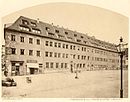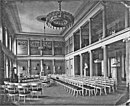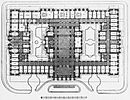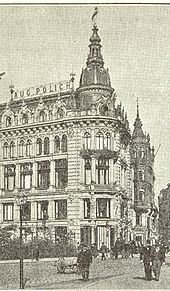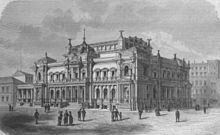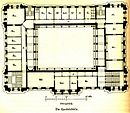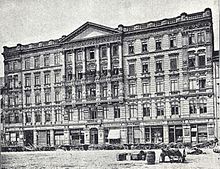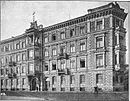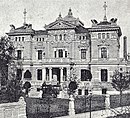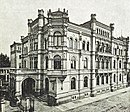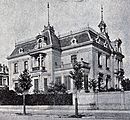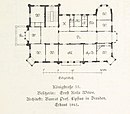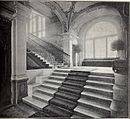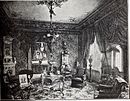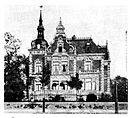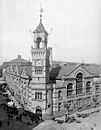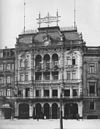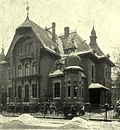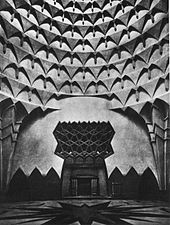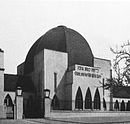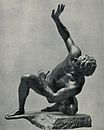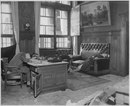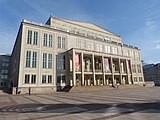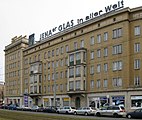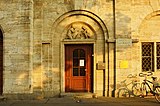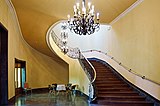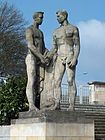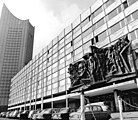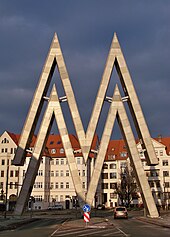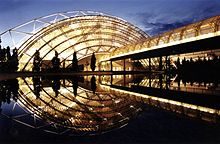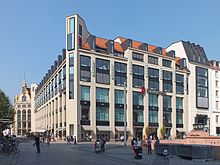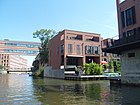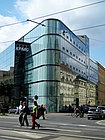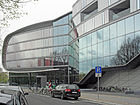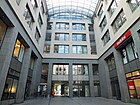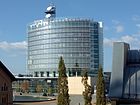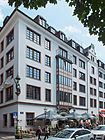Architecture in Leipzig
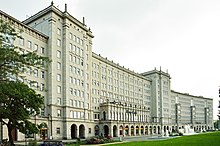
The history of architecture in Leipzig stretches from the Middle Ages to the 21st century. Numerous typical buildings and valuable cultural monuments from different epochs are still preserved or have been rebuilt. In terms of architectural history , Leipzig begins with a number of buildings in the Romanesque style . An example of the Gothic architecture in Leipzig is the late Gothic vaults of the St. Thomas Church (1482/1496). In modern times , the old town hall was expanded in the Renaissance style. The city experienced the high point of urban planning and artistic development from around 1870 to 1914 with historicism , reform architecture and Art Nouveau . Numerous trade fair palaces, commercial buildings, representative buildings such as the imperial court and the town hall and the passages and courtyards known for the city were built . After the First World War , Leipzig became known for its neoclassicism . During the air raids on Leipzig in World War II , large parts of the city center, rich in historical buildings, were destroyed. (Socialist) neoclassicism and modernism followed in the post-war period .
Architectural history
Romanesque and Gothic
Leipzig emerged on the grounds of the Matthäikirchhof as "urbs LIPSK" (Slavic: Lipa = German linden tree ) around 929. The urbs LIBZI castle was first mentioned in 1015 in the chronicle of Merseburg bishop Thietmar . The Leipzig art historian Herbert Küas conducted research there from 1950 to 1956. The castle was destroyed in 1217, and the later Leipzig Barefoot Monastery was built here in 1253 . The oldest churches of St. Nikolai (1165) and St. Thomas (1212) are of Romanesque origin. In the 13th century the monastery of St. Thomas and the monastery of St. George were built . The later Katharinenstraße was named after a Romanesque St. Catherine's Chapel, consecrated around 1233 . The later St. Pauli University Church emerged from the Dominican monastery founded around 1230 . The Peter Street was also of the Romanesque chapel of St. Peter named.
In the 13th century there were four castles, of which only the Pleißenburg remained as a margravial castle. In 1270 there was a council consisting of twelve councilors. These were subordinate to a margrave mayor from the Pleißenburg.
Important Romanesque buildings in Leipzig are or were:
- The Andreaskapelle Knautnaundorf is one of the oldest buildings in Saxony, the chapel was built around 1100. The original Romanesque round chapel with a semicircular apse was built on the model of the round chapel that Wiprecht von Groitzsch had built for his wife at the Groitzsch family castle . At the end of the 15th century the semicircular apse of the rotunda was demolished. In 1720 a baroque octagon was placed on top of the Romanesque, round tower .
- The church in Leipzig-Thekla was built in the 12th century as a massive structure made of quarry stone masonry - consisting of a rectangular nave with a rectangular east choir. There is a rectangular tower in the west.
- The foundation walls, walls of the nave and the choir as well as the portal of the Gnadenkirche at Rittergutstraße 2 in Wahren date from the 12th century. Likewise the font and the door leaf.
- The Nikolaikirche in Leipzig was originally a Romanesque, three-aisled basilica. Remains of the masonry and the westwork with the two corner towers are still preserved from the basilica. From 1784 to 1797 the building was rebuilt in the classicism style based on designs by Dauthe .
The important Gothic St. Thomas Church was built from 1482 to 1496 on the remains of a previous Romanesque building as a late Gothic hall building. The nave still shows the original Gothic ribbed vault with probably reconstructed coloring from the 15th century. The facade comes from historicism (1877–1889).
- Buildings in the style of the Romanesque and Gothic
Church in Leipzig-Thekla
Nikolaikirche , largest church in Leipzig
Thomaskirche , one of the two main churches in the city
Gothic ribbed vault of the St. Thomas Church
Leipzig Fair and Renaissance
Around 1500 Leipzig had about 7,000 to 8,000 inhabitants, but was not as important as Erfurt , which had 13,000 inhabitants at the same time. In 1497 and 1507 , the Leipzig Fair was elevated to the status of an imperial fair through imperial fair privileges . The provisions of the Leipzig trade fair privilege were particularly at the expense of other regional trading centers such as Erfurt, Halle and Magdeburg, because the privilege of 1507 said that within a 112 km radius of Leipzig no trade fair, no fair and no business and sales were allowed - that was first Visiting the Leipziger Messe and previously all goods had to be offered in Leipzig. This meant that trade fairs in Erfurt, Halle and Magdeburg were prohibited. Leipzig thus developed into a supraregional important trading center in Central Germany .
Buildings such as the town hall , the armory, the council scales , the stables and the granary were built in the Renaissance style for trade. Hieronymus Lotter gave the old town hall its current facade in 1556/1557. The “Leipziger Erker” has had its very own tradition in Leipzig since the 16th century. The first stone bay was built in 1523 at the house at the golden snake . This type of "bay windows became increasingly popular". The art historian Wolfgang Haubenreißer notes that the Renaissance oriels of Hieronymus Lotter in particular influenced the other homeowners. Lotter's works are the one-story box oriel from 1556 at the old town hall, the Pappenheimer in the courtyard of the Pleißenburg and the two-story corner oriel at Lotter's house from 1550 at Katharinenstrasse 26.
Important buildings of the Renaissance in Leipzig are or were:
- Old Nikolaischule , built in 1597. The painted wooden ceiling in the entrance area of the house, the city coat of arms above the door and the door walls made of Rochlitz porphyry tufa are from the Renaissance and the 16th century.
- Moritzbastei . A two-wing building on a pentagonal floor plan, built by Hieronymus Lotter from 1551 to 1554.
- Council scales, built by Hieronymus Lotter in 1555. The scales were in the house . Leipzig was given the horizontal law in 1507 and weighed and cleared all goods in the Alte Waage building .
- Old town hall, built by Hieronymus Lotter in 1556.
- Buildings in the style of the Renaissance
Old scales and north side of the market
Leipzig town houses and bay windows from the Baroque era
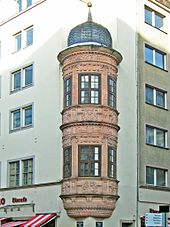
After the Thirty Years' War , Leipzig achieved a leading role as a trade fair city in Central Europe and, thanks to its own trade connections in all directions, it developed into one of the most important trading centers in Europe . The Baroque began with the construction of the Leipzig Stock Exchange and experienced an independent, bourgeois expression in this city. The Leipziger Katharinenstraße, the Leipziger Marktplatz and the Leipziger Petersstraße developed into places with bourgeois, four-story splendid buildings with multi-story, ornately decorated box cores. As Leipzig was a leader in book printing and the book trade, Leipzig also became a hub for progressive ideas. Outside the city walls, unhindered by guild barriers , numerous manufactory productions arose , which heralded the beginning of Leipzig's industrial development. The trade fair and manufactories were run by large entrepreneurs who were also bankers who had migrated to Leipzig from southern and western Germany. The profit gained was immediately invested in baroque buildings.
The "Leipzig Baroque bay window" was influenced by the two-storey corner bay window on Hieronymus Lotter's house from 1550 at Katharinenstrasse 26. The two-storey corner bay window of the Romanushaus at Katharinenstrasse 23 corresponded with the bay window in Hieronymus Lotter's house. An "important link between the Leipzig oriels of the Renaissance and those of the Baroque" was the oriel of the house at Hainstrasse 3, called Weber's Court . The bay window from 1662 is two-story and shows jewelry from the early Baroque: festons , putti , cornucopia . The bay window of Paul Wiedemann at the Princely House consisting of Rochlitzer Porphyrtuff was influenced by the Torgau Hartenfels Castle (Johann Friedrich Building) from 1533–1536. The box oriels at Hainstrasse 8 and in the courtyard of the Stentzlers Hof exhibition center at Petersstrasse 39 to 41 are “a special Leipzig form of the late 17th century” . These oriels are “richly decorated with vegetal ornamentation”. The box oriel at Hainstrasse 8 was described as follows: "The stucco work, floral tendrils and a lion's head holding flower garlands still testify to the extraordinary quality of the craftsmanship of that time".
Significant baroque buildings in Leipzig are or were:
- Webers Hof, Hainstrasse 3. Christian Richter designed the house in 1662 in the Baroque style. The two-storey bay window is particularly elaborate: "This ... box bay window ... is the oldest preserved bay window in Leipzig, if not the first ever built".
- Old trading exchange (1687). “At this point in time, you shouldn't have noticed that Leipzig's first building was being built here in a completely new architectural style, which differed greatly from the previously usual geometrically strictly structured forms based on ancient models. Only when the light facade, decorated with decorative flower and fruit garlands, was completed, the new baroque splendor was revealed. The building by Johann Georg Starcke was the first baroque building in Leipzig.
- The Greater Bosian Garden (from 1680/1692): This was created according to designs by Leonhard Christoph Sturm . Sturm was another baroque artist who was called to Leipzig and was sponsored by Georg Bose .
- Hainstraße 15, built by Wolfgang Bachmann from 1693 to 1695. The half-timbered house is two window axes wide. An unadorned, wooden, two-story box bay window extends across the entire width of the facade. Nikolaus Pevsner describes this as an intended innovation in order to set itself apart from the ornate bay windows of the neighboring houses through “simplicity, sobriety and unadorned”.
- Romanushaus at Katharinenstraße 23, built from 1701 to 1704 by Johann Gregor Fuchs .
- Knauthain Castle and Apels Garden (from 1702). These were designed according to designs by David Schatz , who lived in the house at Neumarkt 13 in Leipzig, which he himself had built according to his design. Cornelius Gurlitt describes David Schatz's architectural style as follows: "These buildings show a progression from simple Dutch forms to the Baroque, the latter, however, expressing itself more in added ornament, not in an inner liberation."
- Torhaus Dölitz , Helenenstraße 24. The model was the architectural style of Cornelius Floris : “The earliest evidence of the transition from the Renaissance to the Baroque, which ... was based on Nordic models ”.
- Royal house at Markt 17, built from 1705 to 1706 by Johann Gregor Fuchs.
- Fregehaus at Katharinenstraße 11, rebuilt by Johann Gregor Fuchs from 1706 to 1708 using still visible Renaissance components from around 1535 (portals). The client was Gottfried Otto.
- Bose House at Thomaskirchhof 16, built by Nikolaus Rempe from 1711 to 1712. The builder was Georg Heinrich Bose .
- Schillerhaus at Menckestraße 42 in Gohlis , built in 1717 in the Baroque style.
- Coffe-Baum at Kleine Fleischergasse 4, built by Adam Jacob from 1717 to 1719.
- Hainstraße 13, built by George Werner from 1744 to 1746. The three-story box oriel is made of stone and stucco. The side surfaces are slightly concave.
- House of the Golden Snake (Barthels Hof) , built by George Werner from 1747 to 1750.
- Zum Grönländer at Petersstrasse 24 / Sporergäßchen, built by George Werner from 1749 to 1750.
- Aeckerleins Hof . Peter Hohmann had the building built in the baroque style from 1708 to 1714 by Johann Gregor Fuchs and Christian Schmidt.
- Greek house on Katharinenstrasse No. 4, built in 1640.
- Hohmanns Hof at Petersstrasse 15. Peter Hohmann had the building built by George Werner in the Baroque style from 1728 to 1731.
- Jöcher's house . Merchant Johann Christoph Jöcher had the building built in 1707 by Johann Gregor Fuchs in the Baroque style. The portal with the female figures on the balcony was created by Christian Döring in 1736 .
- Koch's yard . The banker Michael Koch had the building built from 1735 to 1739 based on designs by George Werner.
- Hainstrasse 8 . The oldest surviving town house in Leipzig at Hainstrasse 8 dates from around 1550 to 1560. It was during the Renaissance period when the solid construction replaced the half-timbered construction. Half-timbered construction itself was banned in Leipzig in 1559. The builder was Antonius Lotter , brother of the council builder Hieronymus Lotter. At the beginning of the 18th century, the building received an elaborately designed, baroque box bay. Russian students who were trained in Leipzig on the orders of Tsarina Katharina in the 1760s also lived here, according to Alexander Nikolayevich Radishchev .
- Baroque houses and bay windows in Leipzig
More pictures are here to find.
Rococo (18th century)

Gurlitt describes that in the 1830s the Rococo appeared in Leipzig in the same forms as Jean de Bodt and Longuelune and Knöffel brought to bear in neighboring Dresden in Saxony.
Gurlitt describes Rococo buildings in Leipzig. The Rococo style was represented in Leipzig by George Werner, who liked to combine the windows of an axis with pilaster strips across different floors . Rococo buildings in Leipzig are or were:
- Katharinenstrasse then 27 (now 19): The facade is nine axes wide with four upper floors. On the building, the Knöffel construction mixes with the Baroque style. The portal was still baroque with its pilasters set over the corners and a curved cornice above the basket arch of the door. The building that has been preserved is also called Hannsen's House after its builders Justus and Ludolph Hannsen . The Hannsen brothers had it designed by George Werner in the Rococo style from 1748 to 1749. Here, too, windows across the four upper floors were combined with pilaster strips to form vertical groups. The windows in the central axis of the facade are roofed, underneath there are rocailles . Rocailles can also be found in the wall panels under the side windows.
- At market no. 5: Longuelune-style pilasters with an elaborate panel structure to the elegantly rich Rococo gable.
- At market no. 14: Large building with simple architecture. Between the simple right-angled or ears-studded windows on the various floors there is a “plain, polished mirror”.
- Hainstrasse No. 11 and Fleischergasse No. 19: The rear building had two bay windows. On the front building there was a coat of arms with two crossed anchors. The house was given “slightly curved ornaments under the bay windows” on both facades and was “beautified both on Hainstrasse and Fleischergasse” during the Rococo era.
- Katharinenstraße No. 7: Building with simpler Rococo ornaments, which is only three window axes wide. The house stands at the end of the Rococo in Leipzig: "The building should mark the end of the direction that culminates in Katharinenstrasse No. 29."
- Kupfergässchen No. 18 Silver Bear : The client was the printer Immanuel Breitkopf , who had it rebuilt in 1764. Its axis towards Universitätsstraße was designed in "rough Rococo". Originally there was an elaborately designed, large portal on the ground floor, above which a bear holds a cartridge. The stucco ornament was handled in a very special way: "The crowning of the windows is indicative of the handling of the stucco ornament at that time."
- The councilor and merchant Gottlieb Beck had the house at Klostergasse 5 designed by George Werner from 1740 to 1741 in the Rococo style. The building is on the site of the former Thomas Monastery , which is why it is also known as the Old Monastery .
- Peterstraße No. 24. Very stately but simple house with many simply used pilaster strips in the style of Knöffel and with rococo decoration on the bay windows that go through three upper floors.
- Peterstrasse No. 13
- Corner of Reichsstraße and Brühl Rother Löwe
- Reichsstrasse No. 38
- Katharinenstrasse No. 29 (today 21): The client was Gottfried Winckler , who also ran his company, a bank and exchange business and a spice trade in his house, which had belonged to the Winckler family since 1654 and also served as a residential building. The building was strongly influenced by Knöffels pilaster architecture: “Pilaster architecture with the three upper floors of the Knöffels style, with Rococo ornaments in the parapets.” At the same time, the building was the climax of Leipzig's bourgeois Rococo - “which culminates in Katharinenstrasse 29 Direction. ”The ground floor was divided into three parts, the courtyard was closed, the storerooms were in the back of the house, and the writing rooms on the right. The stairs to the upper floor were particularly elaborate. This was covered with Delft tiles on the parapet. The rooms on the first floor had good parquet floors , complete paneling of the walls and beautiful doors with elaborate profiles, as well as a ceiling painting by Adam Friedrich Oeser .
- Another Rococo building in Leipzig is the Gohliser Schlösschen .
- Rococo pilaster strip architecture in Leipzig
Classicism (19th century)
The Leipziger Messe and the associated market advantages played an important role in Leipzig's industrial development. New exhibition buildings were created for the new form of the sample fair. In addition, the widely ramified Leipzig banks and financial markets were important for the industrial development of the city, for which the old trading exchange was used. Another factor in the development was Leipzig's early railway connection to raw material and sales markets. The suburbs became densely built-up mixed areas consisting of workers' living areas and industrial and commercial facilities. The mixed areas grew together with the newly created industrial suburbs in the former village surroundings of Leipzig. As a result, Leipzig's population increased from 33,000 in 1815 to 100,000 around 1870. Leipzig was now one of the leading industrial cities. Representatives of classicism in Leipzig were Friedrich Weinbrenner , Eduard Pötzsch , Albert Geutebrück , Johann Carl Friedrich Dauthe and Carl Gotthard Langhans .
The Old Leipzig Theater , built in 1766, was rebuilt in 1817 by Friedrich Weinbrenner in the classicism style. The unadorned west side was redesigned by Weinbrenner into a “representative, classical entrance front”. The theater curtain painted by Adam Friedrich Oeser was replaced in 1799 by a curtain by Hans Veit Schnorr .
Eduard Pötzsch designed the Masonic lodges Apollo and Balduin zur Linde (1847), the Hotel de Pologne , the Dresden train station and the Bavarian train station in the classicism style .
According to Wolfgang Hocquél, Karl Friedrich Schinkel is the “most important German master builder of classicism”. Albert Geutebrück executed the building using Schinkel's facade design for the Augusteum . The portal of the old university (so-called Schinkel portal ) has remained. According to Schinkel's designs, Geutebrück also built the three-storey, fifteen-axle building of the former rifle house (today Wintergartenstrasse) from 1833 to 1834. Geutebrück also built: Großer Blumenberg , the New Post Building on Augustusplatz, the booksellers' exchange and the Royal Palace .
The concert hall was built in the armory wing of the Gewandhaus from 1780 to 1783 under the direction of the building director Johann Carl Friedrich Dauthe in the classicism style. The ceiling was painted by Adam Friedrich Oeser, but it was painted over with an architectural painting by Johann August Giesel from Dresden in 1833 . Dauthe designed the summer house of the banker Löhr (1772) and rebuilt the interior of the late Gothic St. Nicholas' Church in Leipzig (1785 to 1796) in the classical style.
The New City Theater was built on the north side of Augustusplatz in the years 1864–1867 in the classicism style based on designs by the late Royal Prussian Senior Building Councilor Langhans , architect of the Royal Opera House in Berlin . The drafts of the Royal Prussian Building Council for the Leipzig City Theater were based on the Royal Opera House in Berlin, also rebuilt by Langhans in the classicist style. The facade facing the Swan Pond showed parallels to the Athens Acropolis . Like the Erechtheion located there , the Leipzig city theater showed a vestibule facing the swan pond, which was supported by six larger-than-life girls' figures ( caryatids ) instead of columns .
The Roman House was built in 1832/1833 for the publisher Hermann Härtel according to designs by Woldemar Hermann . Although it has classicistic elements, it is regarded as the beginning of the neo-renaissance in Leipzig according to the model and intention. It was based on the Villa Farnesina in Rome, a building from the High Renaissance and, like this Roman villa, featured a five-arched loggia . The building was known for its paintings, including the seven-picture Odysseus cycle and the Cinderella cycle consisting of six individual images . For Ernst Ziller, the house became the model for the realization of Heinrich Schliemann's Renaissance residential palace Iliou Melathron in Athens.
A garden room in the Roman House contained the Odysseus cycle. The artist was Friedrich Preller the Elder . The cardboard boxes of the Odysseus cycle made from the frescoes were exhibited in the Municipal Museum on Augustusplatz. The Preller frescoes were transferred to the walls of the stairwell of the university library before the house was demolished in 1904, but were destroyed in the Second World War.
The ballroom of the house showed six individual pictures of Cinderella in wax colors based on the model of Moritz von Schwind's picture cycle from the years 1852 to 1854. The artist was Julius Naue , who had painted the cycle from 1873 to 1875. When the house was demolished in 1904, the paintings and the masonry were sawn out of the walls and placed in the auditorium of the Second Secondary Girls' School (now the Gaudig School ) in 1907 . When the workers and farmers faculty moved into the Gaudig School building in 1949 , four paintings were replaced by contemporary images. Two of the paintings are now in the foyer of the Leipziger Volkszeitung publishing house .
- Buildings of classicism
Schützenhaus 1835 (later part of the Kristallpalast )
Augusteum before the renovation
Auditorium of the Augusteum
New post office around 1840
Booksellers Exchange 1840
Hotel de Pologne , frescoes (selection)
Franco-German War and Historicism (from 1871)
After Germany's victory in the Franco-Prussian War and the continuous French reparation payments that followed , there was an economic upswing and a building boom in Germany in the style of historicism . The victory monument in Leipzig, which commemorated the victory of Germany and was erected on Leipzig's market square in 1888 , was demolished in 1946 because of "symbolizing militarism ". The monument created by Rudolf Siemering from the Berlin School of Sculpture consisted of the allegory of Germania as well as depictions of various historical personalities from Saxony and the Wilhelmine Empire: Kaiser Wilhelm I. , Kaiser Friedrich III. , King Albert v. Saxony , Chancellor Bismarck and Field Marshal v. Moltke .
Between 1871 and 1914 Leipzig's population rose from 100,000 to 625,000. The suburbs were incorporated. It all started in 1889 with Reudnitz and Anger-Crottendorf . Thonberg , Sellerhausen , Volkmarsdorf , Gohlis and Eutritzsch followed in 1890 . In 1891 came Lindenau , Plagwitz , Schleußig , Kleinzschocher , Connewitz , Lößnig . In 1910 it was Dölitz , Dosen , Probstheida , Stötteritz , Stünz and Möckern .
According to Wolfgang Hocquél, historicism in Leipzig is important: "The largest proportion of the 1,410 monuments in the city of Leipzig are made up of around 700 houses of historicism architecture ...". Representatives of historicism in Leipzig were August Friedrich Viehweger , Martin Gropius , Heino Schmieden , Hugo Licht , Paul Richter , Arwed Roßbach , Hans Enger , Karl Weichardt and Otto Simonson .
According to the art historian and monument curator Wolfgang Hocquél , the Leipzig passages and courtyards are cultural monuments of European importance. There are World Heritage efforts in Leipzig to pay special attention to this cultural epoch, which left its mark on the city unique.
Italian neo-renaissance
The empire that was created when the empire was founded in 1871 after the German-French War won, settled its supreme court in Leipzig. The building was designed in the style of the Italian Neo-Renaissance . After the establishment of the empire, the “Italian Renaissance style was propagated as a 'national style' ”. The Italian Neo-Renaissance was based on Renaissance architecture . The essential design elements of Roman antiquity were adopted. Numerous buildings were built around the Reichsgericht that "took up the formal language of the Renaissance": the New Concerthaus , the Municipal Museum , the Reichspost building , the New Trade Exchange , the University Library , the Royal Conservatory of Music , the Royal Academy of Arts and the School of Applied Arts (designed by Otto Warth ) and a Polytechnic.
Imperial Court Building
The imperial court building was built in the style of historicist architecture based on the models of the Italian Renaissance. The imperial court building was built from 1888 to 1895 based on designs by Ludwig Hoffmann and Peter Dybwad . The dome adorns the sculpture The Truth . Other figures from German legal history adorn the building, including Eike von Repgow , Johann von Schwarzenberg , Johann Jacob Moser , Carl Gottlieb Svarez ( General Land Law ), Anselm von Feuerbach and Friedrich Carl von Savigny . The interior fittings, including the figure and wall decorations, deal with the subjects of investigation, judgment, execution and grace.
- Imperial Court Building
Historicism: Imperial Court Building
Historicism: imperial court building , floor plan
Second Gewandhaus
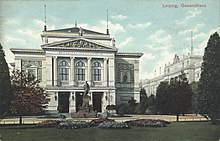
The New Concert Hall in the Musikviertel was built from 1882 to 1884 based on designs by Martin Gropius and Heino Schmieden and opened on December 11, 1884. The building contained two concert halls , changing rooms and music rooms. The main hall was 37.5 m long and 19 m wide. The hall was 14.6 m high. The historicist facade was based on the classic Renaissance: "The facade was created in the spirit of the Hellenic Renaissance direction cultivated by Gropius and in closer connection with the Schinkels theater in Berlin." Otto Lessing created the architectural jewelry . The building became the model for the Symphony Hall in Boston , built in 1900 . The Mendelssohn memorial stood in front of the building until November 9, 1936 , created according to a design by Werner Stein , inaugurated on May 26, 1892. At the instigation of Rudolf Haake , Deputy Mayor Carl Goerdeler, it was torn down during his absence and the Statue probably melted down. In World War II, during the bombing of Leipzig damaged the ruins of the second Gewandhaus was terminated on March 29, 1968th
Municipal Museum
The core of the Municipal Museum on Augustusplatze consisted of a work by the Munich architect and professor Ludwig Lange in “Italian Renaissance forms” from 1855. At the end of 1881, a request was made to significantly enlarge the building based on a design by Hugo Licht . The design was supplemented by Baron Heinrich von Ferstel in Vienna and Heino Schmieden from Berlin. The construction costs were financed with 600,000 marks from the fortune of Francesco Domenico Grassi . In addition, Grassi donated a further 99,200 marks to renovate the inner main staircase. The eastern loggia of the old building, painted by Professor Theodor Grosse , was built up during the work. Since the loggia no longer received any light from the outside, a large skylight hall was created in front of the loggia. In mirror image, a loggia was also created on the western side with indirect lighting through a skylight hall in front of it. The renovation took place from 1883 to 1886.
The facades were made of stone, the figurative jewelry made of Istrian limestone. The building was based on models of the “Italian High Renaissance.” The forms “were made to appear a little more energetic [...] than they were in the original Lange building.” The main staircase was made of Salzburg marble, Istrian limestone and polished granite manufactured. The vaults under the skylights and ceilings showed picturesque decorations .
According to a design by Leipzig architect Hugo Licht, the Royal Conservatory of Music was also built between 1885 and 1887 at Grassistraße 8 (in the music district southwest of the old town) and inaugurated on December 5, 1887.
- Municipal Museum
Historicism: Municipal Museum on Augustusplatz
Historicism: Municipal Museum on Augustusplatz, upper floor
Historicism: Municipal Museum on Augustusplatz, ground floor
Reich Post Building
The Reichspost building was rebuilt from 1881 to 1884 by Paul Richter in the style of historicism based on the models of the Italian Renaissance: "The facades are partly as cuboid, partly as fine brick in the special forms of the Saxon school of Italian Renaissance". The material of the architectural divisions consisted of sandstone. The smooth surfaces were plastered. The building of the Imperial, Post and Telegraph Administration had three main floors with large hall-like rooms. The property comprised 3920 m², of which 2824 m² was built on and 1096 m² was open space. Joseph Kaffsack created six four-meter high attic statues on the main post office , which were commissioned by the Reich, Post and Telegraph Administration and were allegories of post, telegraphy, art, science, trade and commerce. The allegorical figure with wings represented the most modern form of communication at the time, telegraphy . This figure was juxtaposed with a second figure, also winged, which symbolized the letter post. The other four wingless figures in between represented trade, art, science, and trade. This arrangement of figures indicated the importance of rapid communication.
- Main post
August Polich fashion house (until 1936)
Towards the end of the 19th century, the era of large universal and specialty department stores began in Leipzig, including the Leipzig fashion house Gustav Steckner and the Leipzig department store Althoff, between Neumarkt, Petersstraße and Preußergässchen. The southern entrance to Petersstrasse was adorned on the left by the representative August Polich fashion store, which was demolished during the Nazi dictatorship. Roßbach supplied the designs for the Polich department store at Markgrafenstrasse 2 / Petersstrasse / Schloßgasse. The building, equipped with an escalator, was built around 1888 and expanded in 1898. August Polich's department store group also had its own mail order business and lingerie factories. The purveyor to the court August Polich, Leipzig was next to Rudolph Herzog , Berlin; Hermann Gerson , Berlin; N. Israel, Berlin; A. Wertheim , Berlin in the association for the defense of anti-Semitism . In the 30th volume by Merian, Heinz Maegerlein describes his experiences in the old Jewish Leipzig and the Jewish department store Polich. Maegerlein describes Leipzig as an "extraordinarily multi-layered city", including Leipzig as a city of the fur trade and the "industry":
“... and the Jews in Brühl, the most important fur street in the world at the time, in their black caftans, who acted and gesticulated lively in front of their shops with their little ringlets that seemed so strange to us ... and the first escalator of our lives in the progressive department store of August Polich next to Deutsche Bank at the exit of Petersstrasse. "
- August Polich fashion house
New trading exchange
The trading exchange at Tröndlinring 2 was built from 1884 to 1887 according to designs by the architects Hans Enger and Karl Weichardt in the style of historicism based on the models of the Italian Renaissance: "The architecture outside and inside is carried out in Italian high renaissance". On the ground floor there was a 600 m² main hall for the trade exchange and another 280 m² hall for the grain exchange, a further 180 m² hall as well as a reading hall and the chamber of commerce. The built-up area was 2400 m².
- New trading exchange
Villas and townhouses
Numerous residential buildings in the Italian Neo-Renaissance style were also built: the architects Hermann Ende and Wilhelm Böckmann created a two-storey villa with a porch in the shape of an ancient triumphal arch . The building, built in 1876/77, was located at Sidonienstraße 13 and was built for the councilor Julius Meißner . For the engineer and founder Adolf Bleichert, owner of the largest cable car factory, the architects Pfeifer & Handel built a large villa at Feldstrasse 3 (today Lützowstrasse 9) in Leipzig- Gohlis from 1890–1891 . The facades were made of Postelwitz and Cotta sandstone. The building was named after Bleichert's wife Hildegard Villa Hilda . The dome and a side projection were destroyed in 1945. Since 1956 the building has been called Klubhaus Heinrich Budde , after a former technician from the Bleicherts company; there were modifications inside.
For the banker Max Meyer , Heino Schmieden from Berlin created the four-story, seven-window-wide residential building at An der Pleiße 9-10 in 1882 . On the sides of the building were two-storey bay windows with caryatids and a tympanum above . A generous portal with a balcony above marked the entrance area.
Max Pommer created the second Villa Meyer in 1885/86 at Plagwitzerstraße 55 (today Käthe-Kollwitz-Straße 115 ) for the publishing house bookseller Herrmann Julius Meyer . After a general renovation in 2004, the building received the Monument Preservation Prize.
Another building in the Italian Neo-Renaissance style was the Villa Giesecke , built in 1899 by the Berlin government master builder Max Hasak for the type foundry owner Georg Giesecke at Carl-Tauchnitz-Strasse 37 (today Karl-Tauchnitz-Strasse 21).
Bruno Grimm created a four-story, urban house with 12 window axes in 1880 in the style of the Italian neo-renaissance for the factory owner HL Wolff at Täubchenweg 1. The architect Gustav Strauss created the four-story house at Promenadenstrasse 1. The architect and professor at the art academy Constantin Lipsius built the building at Königstrasse 33 for Ernst Keil's widow in 1861. The three-storey building was adorned with an elaborate central projectile and corner core.
Max Bösenberg created two four-story apartment buildings in the style of the Italian neo-renaissance on Stephanstraße in Leipzig. The facades were divided into 15 window axes, the central and corner axes were emphasized like risalit . Bösenberg built the twin house Stephanstrasse 10/12 for the Naumann brothers in the years 1882–1883 . In the years 1881–1882, Bösenberg created the twin house at Stephanstrasse 16/18 for CA Schulze. The two buildings built by Bösenberg on Stephanstrasse have been preserved.
Another four-storey residential building, which was 17 window axes wide, stood at Stephanstrasse 14 and was built in 1880/1881 for the publisher Franz Köhler according to plans by Karl Weichardt .
The Leipzig architect Steib built a five-story residential and commercial building at Packhofstrasse 11–13 for Moritz Lazarus from 1865 to 1866, which was 15 axes wide. The middle part was adorned with colossal columns that supported a triangular pediment. Lazarus was an internationally renowned Jewish scholar and champion of the emancipation of Jews , co-founder and longtime vice-president of the German-Israelite Community Association , an umbrella organization of Jewish communities in Germany, founded in Leipzig in 1869 and expelled from Saxony in 1882 . Alexander Rapaport (1833-1910), a tobacconist, and his wife Maria Rapaport (1841-1912) lived in the building at Packhofstrasse 11-13. The Jewish company Hundert & / Co., which traded in linen and cotton goods and had a branch at 5 Hainstrasse, was also based in the house.
Arwed Roßbach built a villa for the Leipzig merchant August Louis Davignon in 1880/1881. Roßbach also built a villa with a sandstone-clad facade in the style of the Italian Renaissance with stairs and terraces for the publisher Leopold Gebhardt (1880/1881) . In 1894 Roßbach built the Villa Swiderski for the factory owner Philipp Swiderski , known residents were Rudolf Swiderski and Hans Heinrich Reclam . The war-damaged villa was blown up in 1947. Roßbach built the building at Weststrasse 15 in Leipzig from 1874 to 1876 for Consul General Alfred Thieme . The construction costs for 1 m² of built-up area were then 230 marks. From 1886 to 1887, Roßbach built the Villa Gruner at Karl-Tauchnitz-Strasse 19 (old Carl-Tauchnitz-Strasse 35) in the neo-renaissance style for city councilor R. Gruner . The construction costs for 1 m² of built-up area were 335 marks.
Max Pommer built the Villa Oelßner for Wilhelm Oelßner at Karl-Tauchnitz-Straße 13 (old Carl-Tauchnitz-Straße 29) in 1888 . The construction costs for 1 m² of built-up area were 350 marks. Pommer also built Villa Ledig between 1881 and 1883.
- Photographs
- Floor plans
Hotels, restaurants and coffee houses
The oldest café in town since 1711 and thus one of Europe's oldest coffee bars is the baroque house " Zum Arabischen Coffe Baum ".
One of the most famous cafés was the Café Metz in the building Otto-Schill-Straße 2. The two houses of the Dorotheenpassage (Otto-Schill-Straße 1 and 2) were built in 1890/91 by the Leipzig architect and owner Paul Jacobi in the historicism style with a cupola and corner bay was built. Both buildings looked like the gateway to the colonnaded district . They were designed in mirror image and were each crowned with an onion-shaped dome in the shape of the Neo-Renaissance . The café inside was lavishly decorated with stylized flowers. The building at Otto-Schill-Straße 2 has been preserved and is now home to the Faculty of Law, the Faculty of Theology and the Theological Library.
The most famous Leipzig hotel was the "Hotel Kaiserhof" on Georgi-Ring 7. The owner of the hotel was Robert Börner, a caterer with the title purveyor to the court . The building was built in 1889 according to a design by the architect Julius Zeißig in the style of historicism based on the model of the “baroque renaissance”.
The ground floor contained the porter's lodge, an office, a reading room, a small hall and a main hall. The stairwell was lit through large windows. The steps were made of Carrara marble . The main hall showed large paintings of the German imperial family.
- Historic hotels and coffee houses
German neo-renaissance
The German Bookseller's House was completed in 1888 based on designs by Kayser & von Großheim . The ballroom showed wall paintings by Woldemar Friedrich , as well as a glass painting with the title Leipzig as the center of the German book trade . The Leipzig bookseller's house was created in the style of historicism: "The facade of the entire complex is an excellent achievement of the German Renaissance". As a counterpart to booksellers house was graphic elements quarter the German Book Trade house , which was also connected with the Leipzig book trade. The neo-renaissance building erected by Emil Hagberg from 1898 to 1901 served to present the products of the graphic industry. Another building in the German Renaissance style was the Villa Wölker at Karl-Tauchnitz-Straße 15 (old 31), which was completed in 1888 for Consul General Wilhelm Wölker in the neo-Renaissance style based on a design by Max Pommer . The Villa Rehwoldt at Karl-Tauchnitz-Straße 29 (old 45) and the Villa Fritzsche at Karl-Tauchnitz-Straße 37 (old 55) were also built to designs by Max Pommer. Hugo Licht also designed the New Town Hall in the German Neo-Renaissance style. Gerhard Weidenbach and Richard Tschammer designed the Reformed Church in the style of the German Renaissance (1896/99). The Huguenot cross on the church tower is a reminder of the origins of the members of the Reformed congregation in Leipzig, who fled Catholic France as Huguenots.
- Neo-Renaissance buildings
Neo-Gothic
In the neo-Gothic style , the building "Die gute Quelle", Brühl 42, was completed in 1867 based on a design by the architect August Friedrich Viehweger . The building owner was the tobacco shop EB Lomer. The Leipzig University Church of St. Pauli , designed by Arwed Roßbach, was a sacred building in the neo-Gothic style . The St. Peter's Church was designed by the architect 1882/1885 August Hartel and Constantin Lipsius built in neo-Gothic style.
The tower of the Central Market Hall in Leipzig was stylized in the years 1889 to 1891 according to plans by the City Planning Director Hugo Licht, based on the model of the campanile of the Florentine Palazzo Vecchio .
- Neo-Gothic buildings
Historicism: Leipzig Pauline Church
Historicism: Lomer office building, architect: August Friedrich Viehweger , 1867
Neo-orientalism

Hannelore Künzl describes how Otto Simonson mixed elements from different periods when building the Leipzig community synagogue, all of which, however, came from the Spanish-Islamic or North African culture. According to Künzl, Simonson used the horseshoe-shaped arcades in the Leipzig synagogue for the first time. The Leipzig synagogue was not only one of many big city synagogues, it was a special synagogue because Leipzig, as a trade fair city, also had many Jewish visitors. Because of this role that the synagogue in the trade fair city of Leipzig had, the prehistory of Leipzig's Jews and the reasons for the adoption of Islamic styles were particularly important (including Hammer-Schenk ): Only the Saxon Emancipation Act allowed Leipzig's Jews to to found one's own religious community. Besides Dresden, Leipzig was the only Saxon city that was allowed to have a Jewish religious community. The Emancipation Act lifted the building ban on synagogues in Saxony, so that a large synagogue could also be built in Leipzig. For Simonson - according to Künzl - the Orient was not only the country of origin of the Jews, but also the motherland in the religious sense, as the Jewish religion arose there. That is why Simonson brought the Leipzig synagogue into connection with the Orient. Künzl explains that Simonson wanted to overcome his teacher (Semper). While Semper used arabic tapes as ornaments for the Dresden synagogue, the Semper pupil Simonson only used Hebrew tapes, for example in the frame of the eastern rose window and as ornamental tapes in the horseshoe arches of the arcades. The Semper student Simonson wanted to characterize the synagogue as a Jewish building more than his teacher. Models were the synagogue in Cordoba and the synagogue El Tránsito in Toledo , where Hebrew banners frame ornamental fields and window areas. According to Künzl, the synagogue in Leipzig was a type of synagogue that served as a model for many subsequent synagogues.
In 1903/1904 Oscar Schade provided the designs for the Brody synagogue , which was designed in the “neo-Moorish style” , the interior fittings ( Torah shrine , Bima ) in the pogrom night of 9/10. November 1938 was demolished. The Stadtbad Leipzig at Eutritzscher Straße 21 contains a sauna relaxation room, which is designed in the Moorish style. The rooms were designed by Otto Wilhelm Scharenberg and Mathieu Molitor from 1913 to 1915. The Ez Chaim Synagogue , built in 1922 according to designs by the Leipzig architect Gustav Pflaume , was also oriental.
- Buildings of neo-orientalism
Leipzig community synagogue, Otto Simonson
Leipzig community synagogue, Otto Simonson
Ez Chaim Synagogue , Gustav Pflaume
Neo-Byzantineism
The Leipzig Russian Memorial Church was built from 1912 to 1913 in the style of Neo-Byzantinism , a style in historicism, based on the model of the Resurrection Church in Moscow- Kolomenskoye based on designs by Vladimir Alexandrovich Pokrovsky (1871-1931) and furnished in the style of Novgorod icon painting.
- Buildings of Neo-Byzantineism
Neo-baroque
Steibs Hof at Dussmann-Passage Nikolaistraße 28–32, Brühl 64–66 is an example of neo-baroque in Leipzig. The central axis was designed in a particularly elaborate manner: "With its neo-baroque sandstone decor, the central axis trumps even the richest town house facades of the 18th century." The building sculptures are allegories of trade and industry. The building was built in 1907 by the Leipzig master builder Felix Steib . Hugo Licht also designed the Johanniskirche in the neo-baroque style. According to designs by Robert Ludwig & Alfred Hülßner , the Café Bauer was completed by Albert Bohm (1853–1933) in 1889/90 . The café and restaurant on the first and second floors was designed in the neo-baroque style (“in rich baroque forms”)
- Neo-Baroque buildings
Swiss house style
The villa for the consul Friedrich Nachod at Carl-Tauchnitz-Straße 43, built according to plans by the architect Max Pommer 1889–1890, was built in the style of eclecticism in a mixture of Swiss house style and Renaissance . The roof with its free chevron and the wooden decorative elements attached below showed elements of the Swiss house style . This should create the impression of a country house architecture . Friedrich Nachod was the son of Jacob Nachod (1814–1882), the head of the Israelite Religious Community in Leipzig and co-owner of the Knauth, Nachod & Kühne bank , and city councilor in 1888/1889. The Hillerstraße 3 building was also designed with elements of the Swiss house style. It was made for the Secretary of the Chamber of Commerce Dr. Gensel was built in Berlin in 1883 based on designs by the architect Heinrich Stöckhardt . The villas in Lößnig are also built in the Swiss house style, built in 1890 for the owner Consul Limburger based on designs by the architects Karl Weichardt and Bruno Eelbo.
- Buildings in the Swiss style
Reform architecture (monumental and material style) and modernism (from 1900)
According to Wolfgang Hocquél , the Leipzig reform architecture and Leipzig Art Nouveau are important - "The largest proportion of the 1410 monuments in the city of Leipzig have around 700 houses ... the turn of the century".
In terms of urban planning, the construction of the new main train station in 1915 right next to the old town center was important, which strengthened Leipzig's position as an international transport hub. In 1927 there were 294 stock corporations in Leipzig with a total capital of around 321 million Reichsmarks. Leipzig became an important financial center and the seat of the central administration of many large companies and a transhipment point for goods. The German Credit-Anstalt, the largest German private bank, had its seat in Leipzig. The “Messamt für die Mustermessen in Leipzig” founded in June 1916 and the “Central Office for Interested Parties to the Leipzig Sample Storage Fairs” with the industry and business associations successfully demanded a revitalization of the Leipziger Messe. From August 25 to 31, 1918, the first technical trade fair took place in the city center. The historic old town was completely changed because the new trade form of the sample fair replaced the historic goods fair. Therefore, historically grown districts were completely destroyed in order to build trade fair houses such as Handelshof or Specks Hof . The change to an industrial city now took place increasingly. In March 1920 the technical fair was organized outside of Leipzig and showed machine tools and vehicles there. The exhibition area was constantly increased, from 6000 m² in 1920 to 130,000 m² in 1928. Accordingly, goods exported in 1928 amounted to 400 million RM, which was one sixth of German exports. At the last fair before the global economic crisis, 34,420 foreigners visited the fair. Leipzig retained its position as a world trading center. After the First World War, the Leipzig trams were taken over by the city and the trams drove to the suburbs. Wiederitzsch came in 1926, Taucha and Engelsdorf in 1927 , Markkleeberg -Ost and Liebertwolkwitz in 1928 , Thekla and Marienbrunn in 1931 . In 1929 a general development plan was drawn up. Accordingly, the old town should remain free of high-rise buildings and skyscrapers should be built outside of the grown historical old town. The so-called ring was specially created for this purpose. The global economic crisis of 1929 put an end to Leipzig's economic boom.
Völkerschlachtdenkmal
The Völkerschlachtdenkmal (designed by Bruno Schmitz ) is an example of the monumental style of reform architecture around 1900. The monument is “monumental in size” and is the “most colossal expression of the Wilhelmine era”.
The outside shows rustication ; In the reform architecture, value was placed on the effect of the material (in addition to the monumentality). The monument was created from regional building material ("indigenous granite porphyry"). It is a synthesis of structure and architectural decoration ("fusion of architecture and plastic"). The Michael relief was created by Christian Behrens . The colossal figures were created by Franz Metzner . They are located in the Hall of Fame and are almost 10 m high figures depicting allegories of bravery, strength of faith, popular strength and willingness to make sacrifices.
- Volkskraft: "A thoughtful mother nourishes her twin pair with devoted love - the symbol of the proudly rejuvenating German strength".
- Strength of faith: "A father who, in indomitable strength of faith, maintains a devotional composure in the face of unheard-of misfortune, grants refuge and support to the son who has sunk into his lap praying - a symbol of German piety".
- Bravery: "A warrior who is ready to fight shows in a superior manner the resolve and the ability to stand up against the overwhelming force of the enemy fate with all his might - the symbol of German heroism".
- Willingness to make sacrifices: “With all classes, ages and genders, an unprecedented willingness to make sacrifices developed with the feeling of the highest appreciation of the patriotic existence and welfare, which renounced everything in order not to abandon the national idea. Whoever could went into the field. Even women ... "
- Sculpting work
LVZ building, Volkshaus and ATSB school
The Leipzig civil engineer and architect Oscar Schade created the designs for the Richard Lipinski House in Tauchaer Strasse (now Rosa-Luxemburg-Strasse) 19 to 21. The house was opened in 1910 as the publishing house of the Leipziger Volkszeitung (LVZ ) built. There was also a Lenin memorial in the building. The house was designed "in the industrial architecture of Art Nouveau".
In 1912/1913, Schade was also responsible for planning the residential buildings in the Marienbrunn garden suburb in the style of reform architecture .
In 1904 Schade also supplied designs for the Volkshaus with a “ neo-Romanesque ” sandstone facade. During the Kapp Putsch , the building was shot at and set on fire on March 19, 1920. In 1928 the house burned down again. On May 2, 1933, the SA occupied the Volkshaus.
In 1903/1904 Schade also designed the Brody synagogue , which was opened in the pogrom night of 9/10 November 1938 was demolished.
The Workers' Gymnastics and Sports School (ATSB School) at Fichtestrasse 36 in Leipzig was designed in 1924/1925 by architect Oscar Schade. On March 23, 1933, the building was occupied by the Sturmabteilung and further school operations were prohibited.
In 1936, Oscar Schade also remodeled the Villa Schreiber at Beethovenstrasse 16. The villa was built in 1891 in the Italian Renaissance style for the banker Dr. Walter Schreiber according to plans by Max Pommer. Schreiber was co-owner of the Leipzig banking house Herz Cusel Plaut, which was liquidated as part of the Aryanization in 1933. The banking house was named after Herz Cusel Plaut (1783–1837). The founder was his son Jacob Plaut, after whom the Jacob-Plaut-Stiftung and the Leipzig Jacob-Plaut-Straße are named. After the Jewish bank was liquidated in 1933, the villa was also confiscated in 1935. The 1936 renovation was designed by the architect Oscar Schade. Inside, very rich double doors from the construction period have been preserved.
The tomb for the architect Oskar Schade is located in the Leipzig South Cemetery, Section II, election point no. 185 and shows the masonic badge .
- LVZ building, Volkshaus and ATSB school
Volkshaus on Karl-Liebknecht-Strasse (2013)
Art Nouveau houses and the Richard Wagner National Monument
Fritz Drechsler , Raymund Brachmann , Josef Mágr , Paul Möbius , Alfons Berger and Paul Lange are considered to be representatives of Art Nouveau architecture in Leipzig. Works are the building at Paul-Michael-Strasse 6, the building at Menckestrasse 19, the Künstlerhaus , the Riquet-Haus and the Märchenhaus from 1906/1907.
The Villa Görke at Paul-Michael-Straße 6, built in 1904 based on designs by Paul Möbius, shows a multitude of three-dimensional shapes and is a “particularly creative variant of Art Nouveau”.
The house at Menckestrasse 19 in Leipzig-Gohlis , built in 1903/1904 based on designs by Alfons Berger, shows a large number of different window formats and "is one of the most interesting examples of Art Nouveau in Leipzig". In the gable area there are winged, scantily clad elves that were created using the plastering technique. They wear festoons and flank a cartouche depicting a resting lion.
The Leipzig sculptor Carl Seffner designed Adam with Klinger's facial features in his bronze relief Adam and Eve at the Leipziger Künstlerhaus . The base of the Leipzig Richard Wagner National Monument, created by Max Klinger from 1904 onwards, shows themes from the Ring of the Nibelung :
“The front of the block shows three naked Rhine daughters - symbolizing music, poetry and drama and thus alluding to Wagner's pursuit of the total work of art. On the left you can see Siegfried , Mime and the slain dragon, on the right the Grail Guardian Parsifal and the Grail Messenger Kundry . "
- Art Nouveau buildings in Leipzig
Max Klinger as Adam in Adam and Eva by Carl Seffner
Shop window facades

The building of the Brühl department store was built in the style of reform architecture based on designs by the Leipzig architect Emil Franz Hänsel . Hansel was a member of the Werkbund and was one of the "most original and therefore probably most busy architects in Leipzig". Hansel also built the Dresden Residenz department store and the city of Warsaw office building , Brühl 76/78 (probably the site of the former "Gasthaus Zur Stadt Warsaw"). The City of Warsaw office building had a continuous shop window facade and had the following tenants around 1904: August Schneider wine wholesaler , Vienna & Leipzig; Bernhard Schmidt tobacco products; FA Seiler cloth goods; Arthur Hermsdorf (tobacco shop); Wilhelm Moosdorf Restaurant and Cafe Weissenfelser-Bier-Halle Snack hall.
Messow & Waldschmidt opened the Kaufhaus Brühl GmbH on October 3rd, 1908. Heinrich Hirschfeld and Walter Riess were managing directors . Paul Messow died in 1909 and the managing director Walter Riess married Messow's daughter Gertrud a year later and became the sole director. Otto Mühlstein and Salomon Sigismund Hirschfeld became the new managing directors. As part of the Aryanization, the previous managing directors Riess, Meiser and Pelz were recalled in April 1936, and from September 12, 1936, the Jewish property finally passed into the possession of Knoop Co. GmbH.
Between 1914 and 1916, Leopold Stentzler also built the Messehaus Stentzlers Hof at Petersstrasse 39 to 41 and the Messehaus Dresdner Hof at Neumarkt 21 to 27. The Messehaus Dresdner Hof was built for the entrepreneur Richard Pudor . Stentzler's Messepalast is comparable to Behrens' work: "Leopold Stentzler's Messepalast Dresdner Hof is creatively similar to buildings by Peter Behrens , one of the leading German architects of the time, who demonstrated a similar traditional objectivity in the festival hall of the Cologne advertising exhibition in 1914". The Mädlerhaus Leipzig and the F. Lindner office building were also built according to designs by the Leipzig architect Leopold Stentzler in the style of reform architecture. The Mädlerhaus Leipzig showed a continuous shop window facade.
Krochhochhaus and Europahaus
The Krochhochhaus on Augustusplatz is the first high-rise in Leipzig and also an example of “ Classical Modernism ”. The building, which was built in 1927/1928 based on designs by German Bestelmeyer for the Jewish banker Hans Kroch , met with both rejection and approval. Critics said that the architectural jewelry was unsuitable for a private, Jewish bank: “Also impossible are the intended roof figures, which are supposed to drum on a rather large bell in order to elicit the tone E several times a day ... After all, the private bank Kroch is not Town house , not a public symbol that could be given a privileged effect ”. But others also saw the connections to Italy. The model for the Kroch high-rise was the Torre dell'Orologio clock tower in Venice, built between 1496 and 1499, with the St. Mark's Lions: “The building quotations met with approval in Leipzig, certainly also because of the centuries-old connections to the Italian trading cities and their culture ... The result also convinced them who feared that the tower house would visually devalue the 'most beautiful square in Europe', as they confidently said at the time ”. The second high-rise building was 1928/1929 as a counterweight to Krochhochhaus Augustusplatz that of Otto Paul Burghardt (1875-1959) designed Europahaus built.
- Krochhochhaus and Europahaus - classic modernism
German National Library and Sculptures
The building of the German National Library at Deutsches Platz 1 was built from 1914 to 1916 according to designs by Oskar Pusch .
Above the main entrance of the building there are busts of Otto von Bismarck , Johannes Gutenberg and Johann Wolfgang von Goethe , the latter signed by the Dresden sculptor Fritz Kretzschmar . On the main facade there are seven larger than life sculptures that stand on consoles above the ground floor zone. These figures by Adolf Lehnert and Felix Pfeifer are allegories for technology , art , justice , philosophy , theology and medicine , flanked on the side by the figures of the writer and reader by Johannes Hartmann with the coats of arms of the city of Leipzig (left) and the Börsenverein (right ). The following inscriptions can be read above the main entrance: "Scripture lends body and voice to mute thoughts, through the centuries the river carries them." And "Free place for free speech, free research, safe haven, pure truth protection and shelter" . The building rejects conventional historicism in favor of reform architecture: "This architecture does not follow a certain style model, rather the different details are handled completely freely in the sense of adaptations and combined to form a facade design that seeks to set itself apart from models of all kinds".
- German National Library
Petershof exhibition center and sculptures (until 1938)
The Petershof exhibition center at Petersstrasse 20 is an example of “Classical Modernism” and was built for the publisher Josef Mathias Petersmann based on designs by Alfred Liebig : “When structuring the main front with strongly protruding window frames , Liebig reduced the traditional facade architecture to the simplest forms, but avoided the hallmarks of modernity - ribbon windows and insubstantial outer walls. Instead, the sparseness is refined with high-quality natural stone (Cannstatter travertine) ”.
The Leipzig artist Johannes Göldel (1891 – after 1946) created the seven larger than life sculptures, which are located on consoles above the ground floor zone. They are people whose activities are directly linked to the history of the building.
The figures, starting from the left, represent: Building Director Ludwig Fraustadt, Kommerzienrat Felix Geissler, Banker Hans Kroch , who procured the building loan, Lord Mayor Karl Rothe , who was involved in the construction, Exhibition Director Raimund Köhler, Architect of the House of Alfred Liebig and Exhibition Director Edgar Hoffmann. With the attached attributes, the figures also symbolize music, applied arts, trade, drama, trade fairs, architecture and industry. Since Hans Kroch was Jewish, the statues were removed as part of the November pogroms in 1938 at the "instigation of the National Socialists". In 1994, the Leipzig sculptor Markus Gläser created true-to-original copies, which were placed on the facade in 1995 in an old place. The facade is a listed building.
- Petershof exhibition center
Celebration hall at the New Israelite Cemetery (until 1939)
An example of a modern sacred building in Leipzig was the celebration hall built between 1926 and 1928 on the new Israelite cemetery (designs by Wilhelm Haller ). The dome showed "oriental architectural jewelry that the architect had become acquainted with on various trips." This orientalizing architectural ornament, including the stalactite vault or muqarnas based on the model of the Moorish Naṣridenpalaces in the dome, was associated with the expressionist tendencies of the 1920s. The inscription above the entrance read: כִּי-עַזָּה כַמָּוֶת אַהֲבָה(Eng .: as strong as death is love). The building fell victim to the Reichspogromnacht:
“On November 9, 1938, the outbuildings of the celebration hall fell victim to the arson attacks of the Reichspogromnacht. Although the domed hall remained almost undamaged and was 'not to be addressed as the actual fire ruin' , as the city reported to the Saxon Ministry of the Interior in a report dated November 15, 1938, the building police asked the community to demolish all buildings two days after the fire, as these “ pose a danger” and “ deface the cityscape” . After removing the outbuildings, the community only managed to postpone demolition of the intact domed hall for a few weeks. At the end of the year, the city administration in the person of the building police director Franz Gerlach, the city building councilor Werner Liebig and the mayor Rudolf Haake intensified the efforts to demolish it using various legal pretexts and legal tricks. The hall was blown up on February 24, 1939. "
- Celebration hall in the New Israelite Cemetery
Bear Castle and Jason Memorial
From 1922 to 1924, Carl James Bühring built a textile exhibition center at Härtelstrasse 16-18. He also designed the “Bärenburg” with six 10 m high towers in the Leipzig Zoo in the neoclassical style . The Bärenburg, built between 1929 and 1930, stands at the end of a road axis. Path axes with decorative spaces structure the garden.
The Jason monument is located at the beginning of the main route to the elephant facility. The bronze group is part of the development plan by Carl James Bühring and Johannes Gebbing from 1927, when the zoo was expanded from 7 hectares to 12.5 hectares. The Jason group by the Berlin sculptor Walter Lenck (1873–1952), which received the Grand Prix at the International Exhibition in Buenos Aires , was acquired in 1911 for the Berlin Zoological Garden. The Berlin sculptor also created a 43.5 cm high bronze model of a naked archer. The cast was carried out by the bronze foundry Martin & Piltzing Berlin. The Jason monument of the Leipzig Zoo has stood there since 1928 and was previously in the Berlin Zoo for 17 years. The group of figures at the Leipzig Zoo is 4 m long and 3.50 m wide.
Max Klinger's bronze “Athlete” is the “most important visual artistic work” of the Leipzig Zoo and was set up east of the pachyderm house.
Great Depression and Neoclassicism (from the 1930s)
After the National Socialists came to power, Nazi neoclassicism determined the architecture of Leipzig: "After 1933, the repressive policy of the Nazi regime also took control of the exhibition architecture". Jewish architects had their professional license withdrawn; the German-Jewish architect Wilhelm Haller was still able to flee. In residential construction, the Leipzig architects were “very quickly attuned to the traditional forms of construction and the blood and soil architecture of small housing estates [...] The representative buildings of the new rulers gained the upper hand in the field of urban planning and public buildings in the demands for axiality . “The National Socialist architecture was characterized in particular by the timeless and elaborate building material, including stone , marble , shell limestone , travertine and granite . Porphyry was used in Leipzig in the architectural style of socialist neoclassicism since 1951 .
Entrance building on Prager Straße to the exhibition hall
The global economic crisis , beginning with the New York stock market crash in October 1929, ended the expansion of the Leipzig trade fair in the spring of 1930. According to Peter Leonhardt , it took seven years before the expansion of the Leipziger Messe could be continued: "It was not until 1937 that the project was taken up again under the changed conditions of the Nazi dictatorship and, as in a few places, shows the breaks in 1933 for architectural history". Curt Schiemichen had meanwhile risen to become a "kind of general architect of the Leipziger Messe". Instead of transparent glazing, Schiemichen now worked with ashlar cladding, for example in the entrance building on Prager Straße to the exhibition hall (Technical Fair, new Hall 20 - now Hall 2). During the more recent demolition work at the old technical fair in Leipzig, the listed ashlar entrance portal of Hall 2 was left standing.
Richard Wagner Grove

In 1932 Emil Hipp won the competition of the city of Leipzig for a Richard Wagner monument in the style of neoclassicism , which “enjoyed the special support of the Nazi leadership”. On March 6, 1934, the foundation stone was laid by Adolf Hitler in the presence of Lord Mayor Carl Friedrich Goerdeler for the " Richard Wagner Grove ". According to Markus Cottin , a "monument the size of the Dresden Zwinger" was to be built on the east bank of the newly created Elster flood basin on the Frankfurt Meadows.
According to Wolfgang Hocquél , Emil Hipp's reliefs were a neoclassical work with “an imaginative, allegorical sculptural work of timeless aesthetics”. The neoclassicist sculptor planned 250 tons of marble. By 1944, the order was almost complete. Hip's Leipzig Wagner monument had four sides, each side 10 m long and approx. 3 m high. Standing on a 1 m high base, the monument was 4 m high. The four reliefs dealt with fate , myth , redemption and bacchanal . The sculptor created 19 more marble reliefs with scenes from Wagner's musical dramas, a Siegfried figure and a Rhine daughters fountain, including the relief Hagen kills Siegfried , for the 2.80 m high and 430 m long wall surrounding the monument square . Leipzig paid the 3.6 million Reichsmark expensive work to completion. In the post-war period, Hipps' sculptural work was no longer in keeping with the times in the GDR and the monument was sold. A doctor from Bavaria acquired the main reliefs and placed them on the inside of his courtyard wall. The Richard Wagner Grove was forgotten during the GDR era. The load-bearing concrete block for the main relief was demolished, floor slabs were removed, and parts were built over and changed.
- Hipp - neoclassicism
Merkurhaus instead of Polich department store
During the Nazi era, C&A profited from the Aryanization of Jewish property, advertised NSDAP membership among senior executives, and gave important Nazi politicians expensive gifts. The Jewish department store Pohlich, acquired by C&A Germany as part of the Aryanization, was demolished and in its place the Merkurhaus was built in 1937 in the style of New Objectivity by Karl Fezer (1900–1984), who directed the renovation and new construction of the business premises of C&A Germany. The new building is an office and commercial building with three street facades, designed as a six-storey reinforced concrete frame structure with an elaborate shell limestone cladding. With its two bay-like porches, the building ties in with the Leipzig "bay tradition" from the Baroque and Renaissance periods:
"" The strict horizontal structure through the rows of windows and the strong cornices determine the overall impression. The bay-like porches in Markgrafenstrasse and Schloßgasse are an effective contrast. In line with its original purpose as a textile department store, the house was symbolically placed under the protection of Mercury, the god of trade, to whom a sculpture above the main entrance was once dedicated. The noble effect of the shell limestone for the facade cladding as well as the skillful adaptation to the irregular plot of land give the building a special aesthetic charm even without elaborate decorative shapes [...]. ""
Losses 1943–1945
"Monuments to the Victims of National Socialism"
During the National Socialist era, Leipzig had a large arms industry. This was located in the northeast of the city in Leipzig-Schönefeld and Leipzig-Thekla as well as in Taucha . In 1943 there were 221 armaments factories in Leipzig with 154,119 workers and employees, including 43,905 foreigners and Eastern workers . In addition to ERLA , the largest companies also included HASAG , which produced bazookas and aircraft parts. Due to the fact that many workers were ready for use in the war ("kv. Position") and the increased production requirements, more and more foreigners had to be brought into the production process. Therefore, from June 1944, women from the Ravensbrück concentration camp were also employed, whom the SS placed under the Buchenwald concentration camp from September 1, 1944 . A barrack camp at the Leipzig-Schönefeld concentration camp on Leipziger Permoserstraße was built for these women.
In April 1945, the workers in the Leipzig satellite camps, including 4,000 workers employed by HASAG, were driven on a death march towards Wurzen together with 1,500 ERLA workers . The women of the Leipzig-Schönefeld camp (Permoserstraße) who did not go on the death march were sent to the Abtnaundorf camp, where they were "murdered" by the SS and Volkssturm men.
The Leipzig sculptor Hans-Joachim Förster (* 1929) created the monument, which was inaugurated on April 10, 1970. The "concentration camp memorial stone" is located at Permoserstraße 6-14, east of the Torgauer Straße intersection. The memorial stone is 1.83 m high and consists of Cotta sandstone . A writing plate made of Löbejun red granite is attached to the memorial . In the upper left corner of the writing plate there are five triangles of different sizes as symbols of the concentration camp inmates . The following inscription can be read there:
“A subcamp of the Ravensbrück and Buchenwald concentration camps was located at this point from 1944 to 1945. Thousands of women from many nations were inhumanly exploited here by the fascist armaments company HASAG. We honor the memory of those who suffered and died here "
The sculptor Gustav Tesch-Löffler created the memorial, inaugurated on September 13, 1958, to commemorate the victims of the Leipzig-Thekla / Abtnaundorf subcamp . The "Memorial to the inmates of the Abtnaundorf concentration camp" is located on the corner of Theklaer Strasse and Heiterblickstrasse in Leipzig. From 1943, the subcamp Leipzig-Thekla of the Buchenwald concentration camp was located in Thekla , which became famous through the massacre of Abtnaundorf . The material consists of poured concrete, clad with polished porphyry slabs. On the sides of the memorial flames lick out, from which two arms protrude behind barbed wire. One arm shows an outstretched hand asking for help. The other arm shows a clenched fist that is supposed to point beyond death. The memorial is said to refer to the eighty burned corpses that were found with its inscription. The SS guards locked Hungarian Jewish women in one of the barracks and burned it alive.
“On April 18, 1945, eighty resistance fighters were burned alive by SS murderers at this point. May your death always be a reminder "
Hans-Joachim Förster also created the synagogue monument, inaugurated on November 18, 1966, on the corner of Gottschedstrasse and Zentralstrasse, on the site of the former Leipzig community synagogue . It is intended to commemorate the 14,000 Jews from Leipzig who perished. Leipzig had the largest Jewish community in Saxony.
The dedication on the Leipzig synagogue monument on the sides reads as follows:
|
|
Destruction and capture of Leipzig
During the Second World War , the air raids on Leipzig caused great and far-reaching destruction. This included the attack on the night of December 3rd to 4th, 1943. Leipzig had to complain about the loss of numerous exhibition and commercial buildings, almost all cultural buildings, apartments and numerous university facilities. Around 38,000 apartments were totally destroyed, over 52,000 were damaged, 40% of the city's public buildings were destroyed or badly damaged. Three quarters of all exhibition halls and halls were destroyed. Only 6 of 112 schools were still usable. Almost 5 million cubic meters of rubble made large parts of Leipzig impassable. Of 160 km of tram routes, only 15 km were still passable. The population was 700,000, the number of inhabitants decreased by almost 20%.
The New Town Hall was designed by Hugo Licht and furnished with architectural decorations by Georg Wrba . After the city was captured by American soldiers from the 69th Infantry and 9th Armored Divisions, the historicist building became the subject of particular interest: “Drive to the town hall before you clean it up [...] in there it looks like Madame Tussauds Wax museum! ”. Various historical Leipzig personalities of the time committed suicide in the building on April 18, 1945. The deputy mayor and city treasurer Ernst Kurt Lisso, his wife Renate Stephanie nee. Lübbert and daughter Regina "with red cross bandage" as well as the Mayor of Leipzig (1937 to 1945) Alfred Freyberg , his wife and his 18-year-old "pretty [...] daughter Magdalena" with a "Nazi bracelet" as well as the former Lord Mayor and Volkssturm battalion leader Walter Dönicke and several of his officers. The personalities were captured in photographs by Robert Capa , Margaret Bourke-White and Lee Miller . All photographs have been published except for that of the Mayor of Leipzig, Freyberg, and his daughter, who is known for her beauty and her Nazi badge.
- War losses
Total loss of secular buildings in Leipzig: Kochs Hof ruins .
Total loss of the Leipzig sacred building. View from the New Town Hall to the ruins of the Trinity Church , in 1954 the church ruins were blown up. The community received a building permit for a new church, which was then withdrawn by the SED government.
Goerdeler memorial
A memorial was erected on the southwestern tip of the New Town Hall for Lord Mayor Carl Friedrich Goerdeler, who was in office from 1930 to 1937. Carl Friedrich Goerdeler was sentenced to death on September 8, 1944. The monument consists of a 5 meter deep bell shaft with a diameter of 2.75 meters. A bronze bell hangs in this. Quotations from letters, newspapers and writings by Carl Friedrich Goerdeler can be found around the shaft in chronological order.
Neoclassicism from 1945
Leipzig South Cemetery
In 1948, architectural, neoclassical redesigns of the southern cemetery in Leipzig took place , including the creation of the graves of honor, in whose main axis Walter Arnold created the sculpture in the neoclassical style of resistance fighters . The redesign extends across the entire avenue from the north gate to the chapel and ends in a large complex made of granite .
- Südfriedhof
Messehof exhibition center
The Messehof exhibition center at Petersstrasse 15 / Neumarkt 18 was built in 1949/1950 based on a design by Eberhard Werner (1911–1981). A “three-storey, pilaster-structured central risalit ” in the style of neoclassicism was built on Petersstrasse . The facade is clad with Langensalza travertine , the wall cladding of the hall with travertine . The so-called mushroom column adorns relief-like representations of the working person by Alfred Thiele .
- Messehof exhibition center
Messehofpassage, "mushroom column" with depictions of working people by Alfred Thiele
Socialist neoclassicism from 1951
In line with the cultural program of that time, construction has been carried out since 1951 in accordance with the “16 principles for urban development” in a “national cultural heritage” architectural style. The result was an architectural style of socialist neoclassicism . Representatives of the traditional construction were:
- Adam Buchner : Housing at Grünewaldstrasse / Brüderstrasse / Windmühlenstrasse / Bayrischer Platz and Hermann Duncker- Strasse.
- Heinz Auspurg and Walter Lucas : Housing construction Hermann Duncker- Strasse and Ranstädter Steinweg .
- Martin Weber : Nexö old people's and nursing home at Stötteritzer Strasse 26 from 1958–1960 as an extension of a facility from the 1930s (Arch. Bornmüller). In 1955 Weber created the open-air stage in the central Clara Zetkin cultural park for an open-air theater with 2000 seats in “simple traditional forms”.
- Rudolf Rohrer : Building at Roßplatz 1 from 13 from 1953 to 1956 with architectural decorations by Rudolf Oelzner and Alfred Thiele.
- Wolfgang Geisler , Hans Pape and Heinz Rauschenbach : Geisler, Pape and Rauschenbach designed numerous buildings for research and teaching. These include a student dormitory, the Anatomical Institute of SMEs , the Carl Ludwig Institute for Physiology of SMEs , the Physics Institute of SMEs , and the Chemical Institute of SMEs .
- Hanns Hopp and Kunz Nierade . Buildings for research and teaching, including the German University for Physical Culture (DHfK) and buildings for culture, including the Leipzig Opera House .
- Karl Souradny : Schauspielhaus Bosestraße 1, built from 1955 to 1956. The entrance area shows a portico-like porch with numerous sculptural decorations.
German University for Physical Culture and Opera House
Hanns Hopp and Kunz Nierade created buildings for research and teaching as well as buildings of culture with elaborately designed sandstone facades:
- The German University of Physical Culture (DHfK) was completed from 1951 to 1957 according to designs by the architects Hanns Hopp and Kunz Nierade in socialist neoclassicism ("in traditional designs"). The facades were clad with sandstone . The forecourt was designed with bronze sculptures by Rudolf Oelzner and the sculpture group relay runners by Senta Baldamus .
- The Leipzig Opera House was built from 1959 to 1960 based on designs by Kunz Nierade and Kurt Hemmerling . Here, too, sandstone was used extensively in an elaborate manner - the "sandstone facades" were "structured in flat relief". It is regarded as the construction of the transition: “The project planning began at a time when the period in which the artistic side of architecture was overemphasized and strived for with historicizing forms was drawing to a close ... In terms of design, the new opera house is a transitional work by the architecture of the national building traditions to a new, functionally determined attitude. "In the interior design Hanns Hopp saw a" first step towards a socialist architecture. "The building refers to the" late classicism of the previous building ". On the gable of the west facade there are three-dimensional representations of the muses Klio , Kalliope , Melpomene and Terpsichore . These sculptures are from the previous building, were recovered when it was demolished and integrated into the new building. Hugo Hagen created the gable field above the vestibule of the New Theater , The Poetry that inspires the other arts . Hagen also created the large gable acroterie Apollo, Klio and Calliope . Eduard Lürssen created three pairs of winged Victorias as well as metopes on the back wall of the vestibule, representing the muses Polyhymnia , Erato , Terpsichore, Urania and Euterpe , each accompanied by two geniuses . On the theater's “classically simple saddle roof” there are four gold-plated doves of peace that “symbolically place the building under the theme of peace”. Supraports with bas-reliefs show theater symbols and state emblems.
- Hopp and Nierade - Neoclassicism
Leipzig Opera House , front view
New residential construction
Heinz Auspurg, Walter Lucas and Adam Buchner took care of the new residential construction. From 1950 to 1951 the building complex on Ranstädter Steinweg was completed according to designs by architects Heinz Auspurg (urban development) and Walter Lucas (project) in socialist neoclassicism (“traditional forms”). Alfred Thiele created the numerous bay reliefs .
From 1953 to 1956, the building complex on Hermann-Duncker- Strasse in the Leipzig district of Lindenau was designed by architects Heinz Auspurg (urban development), G. Batteraux, Adam Buchner and Martin Weber (project) in socialist neoclassicism ("traditional forms") completed. It was the first residential development area after 1945 in the working-class district of the west of Leipzig. The buildings were built on former gardens and arable land as well as on formerly rural and agricultural areas. It was part of a new housing construction program in Leipzig. A new district was created around Dunckerstrasse in Leipzig-Lindenau. Apartment units of 1 to 4 rooms with kitchen and bathroom, shops, shopping streets, a post office, a laundry and a paddling pool for children were created.
From 1952 to 1954, the building complex on Gruenewald-, Brüder- and Windmühlenstraße was completed according to plans by the architect Adam Buchner in socialist neoclassicism ("in traditional architectural forms"). Buildings with "plastered facades with porphyry structure " were created.
- H. Auspurg, W. Lucas and A. Buchner - Neoclassicism
Roßplatz 1–13
Rudolf Rohrer took care of the representative buildings. From 1953 to 1956 , at Roßplatz 1–13, a seven- to nine-storey, curved building complex based on Rohrer's designs was built. A “plastered building with travertine structure” was created. The architect collective around Rudolf Rohrer designed the building ensemble with echoes of the Leipzig building tradition. This included "bay windows extending over several floors, as they had shaped the image of the bourgeois house in the Baroque, and arcades that were typical in the Renaissance and Classicism". In the middle part is the tower-like, two-storey Ring-Café with "facades based on Leipzig baroque tradition". It is a "plastered building with travertine structure." The sculptural decoration comes from Rudolf Oelzner and Alfred Thiele. The Ring-Café shows a floor-to-ceiling arched window gallery that is reminiscent of a Baroque orangery and represents a “recourse to the Baroque”.
- Rudolf Rohrer - Neoclassicism
University building
The buildings for the university were provided by the architects Wolfgang Geisler , Hans Pape and Heinz Rauschenbach :
- The anatomical institute at Liebigstrasse 13 in Leipzig was built between 1951 and 1956 based on designs by the architects Wolfgang Geisler and Heinz Rauschenbach. On the east side of the main building there are eight portrait medallions that were created by the Leipzig sculptor Alfred Thiele and represent the medical professionals. Above the entrances to the lecture hall there are two stone tablets that proclaim the principles of anatomy. Two frescos in the large auditorium were created by Schubert and Max Gerhard Uhlig . In addition, a sculpture by the anatomist Wilhelm His by the Halle artist Weidanz adorns the building.
- The Herder Institute at Lumumbastraße 4 was built from 1952 to 1954 for the then workers and farmers faculty. It is a three- or four-story plastered building with divisions in red Rochlitz porphyry tuff. The main entrance is designed in "historicizing forms". Between the windows there are 15 high terracotta reliefs by Gudrun Richter-Thiele .
- The student residence at Nürnberger Str. 48 was designed by architects Wolfgang Geisler and Heinz Rauschenbach between 1954 and 1956. The five-story corner building has a hipped roof and plastered façades with coupled windows. The façade is adorned with the vertical emphasis of the stone structure. It was the first new dormitory building in the GDR for foreign students from Leipzig University.
- Hans Pape built the building for the Leipzig University of Civil Engineering at Karl-Liebknecht-Straße 132 from 1958 to 1960 with a facade traditionally clad with sandstone. The sandstone relief was created by the sculptor Waldemar Grzimek , the mosaic by Georg Eichhorn .
- W. Geisler, H. Pape and H. Rauschenbach - Neoclassicism. Buildings for research and teaching
Sports and cultural buildings
Karl Souradny took care of numerous sports and cultural buildings in Leipzig :
- Schauspielhaus Bosestrasse 1. The theater building on the corner of Dittrichring 19 and Gottschedstrasse 8, built between 1955 and 1956, was designed by Leipzig architects Karl Souradny, Rolf Brummer and Franz Herbst using "neoclassical architectural elements". The building is five storeys high and has a facing made of sandstone slabs on the two lower floors. The entrance area located in Bosestrasse shows a portico-like porch with numerous sculptural architectural decorations, which indicate the function of the building. The auditorium for 900 spectators was clad with wall paneling made of French walnut. The stage is 32 m high. In the main foyer there is a bust of Lessing and a memorial plaque for Friederike Caroline Neuber , which are intended to commemorate Leipzig's important theater traditions.
- The sports forum was also built under the direction of Karl Souradny. The forecourt of the Leipzig Sports Forum was designed with sculptures by Rudolf Oelzner .
- K. Souradny - Neoclassicism
GDR classicism sculptor
A sculptor of classicism in GDR times was the sculptor Alfred Thiele. His works include the column relief on the so-called mushroom column in the exhibition center on the market , the relief work on Roßplatz, the sandstone portrait medallions of important medical professionals on the main building of the Anatomical Institute of Leipzig University and the bay reliefs on the buildings on Ranstädter Steinweg . Rudolf Oelzner created full sculptures on Roßplatz, on the forecourt of the German University for Physical Culture with bronze sculptures, as well as the large sculptures on the forecourt of the Leipzig Central Stadium. Senta Baldamus created the sculpture relay runner , bronze (1975), Friedrich-Ludwig-Jahn-Allee, forecourt of the sports science faculty of the University of Leipzig (former sports medicine institute of the German University of Physical Culture).
- Postwar Neoclassicism
Roßplatz sculptures by Rudolf Oelzner
Sports forum, forecourt design with sculptures by Rudolf Oelzner
Pictorial architecture (from the mid-1960s)
In the second half of the sixties, Walter Ulbricht introduced the GDR-specific phase of "pictorial architecture" in the style of socialist realism with strikingly figural buildings. Were representatives of that time
- Architects Hermann Henselmann , Horst Siegel and Helmut Ullmann : high-rise building of the Karl Marx University (1968/1972) and the main building of the Karl Marx University, which was demolished in 2005 (1968/1974)
- Sculptors Frank Ruddigkeit , Klaus Schwabe , Rolf Kuhrt and Werner Tübke , who furnished the main building of the Karl Marx University , which was demolished in 2005, with sculptures and wall paintings.
- Architects Horst Krantz , Hans Großmann and Klaus Burtzik : Information Center of the City of Leipzig (Leipzig Information) (1969)
- Architects Rudolf Skoda , Eberhard Göschel , Volker Sieg and Winfried Sziegoleit : New Gewandhaus (1977/1981)
University skyscraper
The university high-rise is a strikingly figural structure and was built from 1968 to 1972. The dominant high-rise has the shape of an open book:
“ Here, Henselmann realized his semantic architectural conception of the transfer of meaning through the symbolic imagery of the buildings, which is intended to express the characteristics of a city by means of a quasi-oversized sculpture. The largest skyscraper [...] should be interpreted as a gigantic, open book, the curved roof top also associates the image of a waving flag. "
The main building of the Karl Marx University , which was demolished in 2005, was erected from 1968 to 1974 and was the "political and intellectual-cultural center of the city" during the GDR era:
"For the city center, the construction of the new Karl Marx University complex was the decisive stage in shaping the political and intellectual-cultural center of the trade fair city."
The seminar building on Universitätsstrasse has been preserved from the "GDR building from the 1960 / 1970s". The seminar building is a five-storey 2 Mp reinforced concrete skeleton assembly building with 22 lecture halls of various sizes.
In 1973 the bronze relief " Leninism, Marxism of our time " , created by the artists Frank Ruddigkeit , Klaus Schwabe and Rolf Kuhrt in the style of Socialist Realism , was attached. The main building of the university thus became a socialist building, above whose entrance the bronze relief Aufbruch with Karl Marx 's head was placed. Werner Tübke created an almost 13 m wide mural on the subject of the working class and the intelligentsia for the foyer . In the ground floor foyer there was an almost four meter high sandstone epitaph created by Paul Speck around 1547 for the rector Caspar Borner , which was inserted into the wall. The main building of the former Karl Marx University was demolished in 2007.
- University skyscraper
Main building of the Karl Marx University Leipzig and the university high-rise
Bronze relief departure above the entrance to the Karl Marx University
University foyer, 13 m wide mural by Werner Tübke : Working class and intelligentsia
Swimming pool, Mainzer Strasse 4
The swimming pool at Mainzer Strasse 4 in Leipzig is a copy of the Dresden swimming pool at Freiberger Strasse , which was built according to designs by VEB Projektierung Sportbauten Leipzig ( H. Konrad , G. Nichtitz , E. Kaltenbrunn ). The hall has a sloping ceiling. The concave curved prestressed concrete roof was constructed as a hanging shell structure with prestressing steel that supports precast reinforced concrete panels. The building came into being “when an astonishing willingness to experiment was also allowed in the GDR architecture. This pictorial architecture as a built-up landscape fits in perfectly with the trend of post-war modernism between Brasília and Moscow ... There is also a copy of the Dresden original on the premises of the DHfK Leipzig (near the Sportforum) ... "
Leipzig information
In 1969 the architects Horst Krantz , Hans Großmann and Klaus Burtzik built the information center of the city of Leipzig (Leipzig-Information) with tourist offers, an exhibition and a conference area. The structure was a two-storey building whose roof shape was characterized by "fan-like staggered steel girders". The facade was almost entirely glazed. On the ground floor there was a mocha bar and a counter hall with a decorative copper wall design by Bruno Kubas . There was a movie room on the upper floor, as well as exhibition and conference rooms. In front of the building there was a large open space, framed by three pavilions for exhibition purposes on the east side and smaller green spaces and water features on the west side. The three plastic elements in the fountain, consisting of overlapping basic geometric shapes, were created by Harry Müller in 1972 . You are now on Richard-Wagner-Platz . The ceramic-coated column created by the Leipzig sculptor Herbert Viecenz, on which the history of Leipzig was depicted, was destroyed during the demolition of the information center.
Hypar shell buildings in Leipzig

The 1972-1973 designed by Ulrich Müther (together with Heinz Goth , Eberhard Scholz , Ingo Schönrock and Karl Möller built) Parkgaststätte "Buergergarten" in the DDR-district Leipzig East Doebeln was a shell structure as a hyperbolic paraboloid with about 320 indoor and 650 Outdoor seating, sculptures by Carl-Heinrich Pohl . Ulrich Müther (with Ingo Schönrock) built a similar building with 250 seats in Lonnewitz in 1968/1969 . It served as a rest stop and has since been demolished.
The work was comparable with a number of other hypar shell structures , including the Sternchen in Cottbus, designed by Gerd Wessel , the Ahornblatt (also by Ulrich Müther, Berlin), the Rote Horn (Magdeburg) and the Teepott (Rostock). These were considered "highlights of GDR building history". The building in Döbeln was demolished in 1995 and was identical to the restaurant in Ermsleben .
New Gewandhaus
The Neue Gewandhaus created a collective from 1977 to 1981 under the direction of Rudolf Skoda , to which the architects Eberhard Göschel , Volker Sieg and Winfried Sziegoleit belonged. Rudolf Skoda created a building with a large glass front. The ceiling painting by Sighard Gilles is easy to see through the glass facade . From 1980 to 1981 Sighard Gille painted the 714 m² and 31.80 m high ceiling painting Song of Life , which was inspired by Gustav Mahler's Song of the Earth . It is located on the site of a wall frieze that the painter Wolfgang Peuker created, but paneled and painted over with the ceiling painting by Sighard Gilles. When it is dark, the ceiling painting by Sighard Gilles in the foyer area acts as an interesting “light-architectural effect” in the space on Augustusplatz.
The entrance to the hall is through a passage that widens to a small atrium, where there is a fountain sculpture by Horst Georg Skorupa . This sculpture is intended to remind of the former Leipzig city piper. In the passage is also the marble relief Orpheus , which was made in 1904 by Johannes Hartmann for the world exhibition in St. Louis . In the foyer of the smaller hall there is also a bronze portrait of the former Gewandhaus Kapellmeister Felix Mendelssohn Bartholdy , created by Jo Jastram .
The Beethoven sculpture by Max Klinger is located in the ground floor foyer of the small hall . The gallery of the New Gewandhaus with paintings by Gudrun Brüne , Dietrich Burger , Ulrich Hachulla , Heidrun Hegewald , Susanne Kandt-Horn , Harald Metzkes , Ronald Paris , Nuria Quevedo is located in the foyer of the second floor, which was built around the hall , Arno Rink , Willi Sitte , Volker Stelzmann , Walter Womacka , Heinz Zander and Frank Ruddigkeit .
MM signet
The double "M" is used today for the designation sample fair. The 27 m high steel frame construction is clad with aluminum sheet. The design for the signets erected in 1965 comes from the Leipzig architects Manfred Weigend and Martin Lehmann (born 1934).
concrete
Old provost church of St. Trinity

One piece of work in exposed concrete (French: Béton brut : exposed concrete) is the St. Trinitatis church at Emil-Fuchs-Straße 5–7, which was built from 1978 to 1982 based on designs by a collective from the GDR Building Academy under the direction of Udo Schultz . The facade consists of a "box grid made of concrete". A high, all-round parapet made of dark slate was built over the honeycomb concrete windows as the upper part of the building. The bell tower is 18 m high and does not have a natural stone facing . There are two steel pylons on each of the north and south façades, which extend over the roof. In the pylons on the north side, the copper doors created by Achim Kühn (* 1942) are on the theme of the Path of Faith .
Bird free flight hall in Leipzig Zoo
In 1969 Reiner Grube built a now listed bird-free flight hall in the Leipzig Zoo , consisting of a gable wall made of molded concrete blocks with thermal glazing. The glass roof rises above a free-standing steel structure made of box girders on V-supports. A photograph shows the gable wall made of molded concrete with the following description:
"1969. Happy twittering: the bird house with free flight hall opens its doors. In tropical temperatures it is home to exotic species of birds. In addition, the zoo school is founded. "
Prefabricated buildings
The 5 Mp panel construction was developed for Leipzig under Boehme's direction. From 1963 to 1966, 4-storey prefabricated buildings with a hipped roof were built in the Leipzig- Sellerhausen WK . From 1966, Erich Böhme built the 8-10-storey prefabricated buildings on Leipzig's Johannisplatz together with Eduard Regula and Martin Winkler . From 1968 to 1971 Erich Böhme developed the “Leipzig” variant of the apartment type P2 / 11 together with Thomas Oechelhäuser . The residential complex on Straße des 18. Oktober was created with many architectural details: loggias with colored glass parapets , ceramic mosaics , concrete structures on the gables, concrete form elements in front of the distribution corridors. The variant “Leipzig” of the apartment type P2 / 11 was not only used from 1968/1971 on the housing slabs in Leipziger Strasse on October 18. Also in the residential complex "JR Becher" in Lößnig 1971 was variant "Leipzig" of the apartment type P2 / 11 worked. From 1971 to 1975, the Lößnig new building area was built east of Zwickauer Strasse with 3,082 apartments in exclusively eleven-story apartment blocks (→ prefabricated buildings in Leipzig ).
To round off the Astoria complex on the northern edge of Leipzig city center, 10-storey residential buildings of the central aisle type were built in 5-MP transverse wall construction with 275 residential units for boarding school use, and 320 residential units on the east side of Gerberstrasse. The residential buildings at Gerberstrasse 16 / Kurt-Schumacher-Strasse show a facade structure using vertically offset concrete structural elements by Harry Müller .
International modernity
"Hotel Germany"
The “Hotel Deutschland” (later renamed “Interhotel am Ring”) on Karl-Marx-Platz was built by Helmut Ullmann (1930–1991) and Wolfgang Scheibe (1928–2006) according to designs by the architect Manfred Böhme between 1963 and 1965 was the largest of the three newly built Leipzig hotels. It consisted of a flat tract in the form of a reinforced concrete - framed building and a six-storey ward block in 5MP bulkhead construction. It had a horizontal facade structure and parapets with colored ceramic sculptures . The visual artistic design came from Gerhard Eichhorn (1927–2015). The flat wing along the Grimmaischer Steinweg was demolished at the end of the 1990s as part of the renovation and modernization of the house. Today the house is called "Radisson Blu Hotel Leipzig" and belongs to the hotel chain of the same name " Radisson Blu ".
Fair building on the market and guest house of the GDR government
The exhibition center on Markt , Markt 16, was also built in 1961/1963 based on designs by Frieder Gebhardt . The building is a synthesis of modernity and monument protection: "Modern building tasks [were] with monument preservation issues, as they arose from the neighborhood of the old town hall and the royal house, to be considered [...] with the formation of arcades in the entrance area [...] were also characteristic Leipzig building traditions included ”. In the entrance hall there is a natural stone relief by Hanna Studnitzka and Elfried Ducke on the subject of “Leipzig trade fair activities yesterday and today”.
The guest house of the Council of Ministers of the GDR in Leipzig was built in the years 1967 to 1969 in the style of international modernism based on designs by the architects' collective Fritz Gebhardt or Frieder Gebhardt in Leipzig's music district. The house was one of the most representative buildings in Leipzig. Guests were Erich Honecker , Erich Mielke and Franz Josef Strauss . The furnishings were just as lavish as the one in the GDR government's guest house next to Schönhausen Palace in Pankow. The wall relief by Bernhard Heisig in the foyer is well known. Gebhardt also provided the designs for the construction of the exhibition center on the market (1961–1963), the renovation of the Europahaus (1965) and the construction of the winter garden high-rise (1970–1972).
Interhotel Merkur
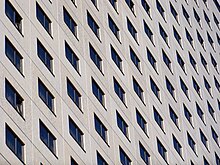
The Interhotel Merkur is an example of “ international modernism ( functional style )” . The GDR had been a member of the UN since 1973 and established international relations with all countries. Japan was one of the first western industrialized countries with which the former GDR established important trade relations. This is why the Japanese construction group Kajima Corporation Tokyo built the IHZ in Berlin and the five-star luxury hotel Merkur as a follow -up contract . The skyscraper was built from 1978 to 1981 by the Kajima Corporation Tokyo. The building has 29 floors. Suspended large concrete slabs shape the facade. The plates have a ceramic attachment, in a light ocher shade at the base zone or a dark ocher shade. The shape of the orthogon determines the floor plan, the surfaces on the facade and the shape of the building.
Reconstruction, Contemporary Modern and Postmodern
The New Fair was built in the "contemporary modern" style from 1992 to 1996 based on designs by Gerkan, Marg and Partners . It is a 243 meter long, 80 meter wide and 30 meter high glass hall, which is characterized by an “unusual light architecture”. The glass barrel vault consists of an external tubular steel construction and glass surfaces suspended below. This hall is the main entrance. The visitors can enter the five square exhibition halls through glass tubes.
The Museum of Fine Arts at Katharinenstrasse 20 was built between 2000 and 2004 according to designs by the Berlin architects Karl Hufnagel, Peter Pütz and Michael Rafaelian. It is a 36 m high glass cube imagined as a “crystal”. The building has a double-walled, glass curtain wall. A chimney effect is created between the two glass fronts . This avoids heating up in summer and heat loss in winter. Inside there is a 20 m² mosaic by Stephan Huber.
The Petersbogen at Petersstraße 36 was built from 1999 to 2001 in the contemporary modern style based on designs by Gerd Heise for HPP Hentrich-Petschnigg & Partner. The Collegium iuridicum of the university, where Johann Wolfgang Goethe studied, was located here from the 16th century . Today the law faculty with its seminar library is located again in the Petersbogen .
The publishing house of the Leipziger Volkszeitung was in today's Richard-Lipinski -Haus at Tauchaer Straße (today Rosa-Luxemburg-Straße) 19 to 21, which was built according to a design by Oscar Schade . In the 1950s the publishing house moved to another building at 19 Peterssteinweg. From 1997 to 1999 the building was modernized according to designs by the architects Heiken and Partners.
The bowling club on Wilhelm-Leuschner-Platz , which was built in 1987 by Winfried Sziegoleit and can be seen as an example of GDR postmodernism , is considered to be the first postmodern building in Leipzig . The Strohsack-Passage at Nikolaistraße 6-10 and Ritterstraße 7 was built from 1995 to 1997 according to designs by Bernd Appel, Anuscha Behzade and Heike Bohne in the style of postmodernism . The remains of the facade from the Baroque period up to the 2nd floor have been preserved.
The Bauwens house at Burgplatz 2 was built from 1991 to 1994 according to designs by Gerd Heise for HPP Hentrich-Petschnigg & Partner . The colossal pillars with granite cladding combine the ground floor and the first floor as a two-storey base and therefore imitate the colossal pillars of antiquity . The middle section of the facade extends like a risalit .
The building of the MDR transmission center was built from 1991 to 1994 according to designs by Gerd Heise for HPP Hentrich-Petschnigg & Partner. A 13-story high-rise made of glass with a concave south-facing side rises above a four-storey sandstone base .
The extension for the building of the German National Library was designed in the form of a book spine according to a design by the Stuttgart architect Gabriele Glöckler . The building was inaugurated on May 9, 2011.
The architecture of the Porsche customer center in Leipzig is based on the shape of a diamond . The building consists of a concrete base and a 32 m high tower resting on it, shaped like a top and clad with metal.
The administration building Verbundnetz Gas AG (VNG) at Braunstraße 7 in Leipzig-Schönefeld was built from 1995 to 1997 based on designs by Eike Becker , Georg Gewers, Swantje Kühn and Oliver Kühn. The facade consists of a 120 m long glass bar that runs parallel to the street. There is a glass cubic tower on the north side.
The KPMG administration building at Münzgasse 2 in Leipzig-Südvorstadt was built between 1996 and 1997 based on designs by Till Schneider and Michael Schumacher. The six-storey building is also known as the “iron house” because of its idiosyncratic structural shape. In 1999 the building was awarded the Leipzig City Architecture Prize for promoting building culture.
The townhouses at Nonnenstrasse 17-21 with the transition to Holbeinstrasse in Plagwitz ( White Elster ) were built from 1998 to 2000 according to designs by the architects Fuchshuber & Partner. Apartments, office lofts and service units were created. In the immediate vicinity are the historic buildings of the former Saxon wool yarn factory Buntgarnwerke , built between 1887 and 1895 according to designs by the architects Ottomar Jummel and Handel & Franke.
The Bio City was designed by Ingrid Spengler and Fredo Wiescholek 2001-2003 in Probstheida built. The building shows a "North German-looking clinker facade". The term “Bio-City” describes the modern research facility Biotechnological-Biomedical Center BBZ of the University of Leipzig.
The central building in the BMW plant in Leipzig was built in 2004 to designs by the London architect Zaha Hadid . In 2005 the building was awarded the Leipzig City Architecture Prize and the German Architecture Prize.
The New University Church of St. Paul was built according to a design by Erick van Egeraat , Martin Behet, Roland Bondzio and Yu-Han Michael Lin. The historicizing gothic rose window and the tracery window are intended to be reminiscent of the historic St. Pauli University Church .
The market gallery at Markt 11-15, built between 2001 and 2005, is intended to commemorate the Bismarckhaus and Stieglitzens Hof . Instead of the splendid neo-baroque buildings that had been destroyed in the war, the modern trade fair office was built in the 1960s . The trade fair office was demolished in 2001 and the market gallery was built from 2001 to 2005 based on a design by Norbert Hippler (Rhode / Kellermann / Wawrowsky) with a facade by Christoph Mäckler . With its roof landscape , the building complex should be reminiscent of the historical building silhouettes.
As a historicizing building was constructed 1993 to 1996 to a design by Alexander von Branca of the Thüringer Hof .
Gerd Heise built the " House of the Book " atgerichtsweg 28 from 1993 to 1996 for HPP. The building complex consists of a mixture of old and new buildings:
“The result was a building ensemble that consists of three clearly separated structures and is also connected to the only surviving wing of the previous building. With its shape, the building refers to the large number of printing works, bookbinders, book-house deliveries and publishers that were once located in the former graphic quarter, which had a typical architecture. "
The “ Trifugium ” building complex on Barfußgäßchen 11/13/15 was built from 1904 to 1906 according to a design by Arthur Hänsch, but was partially destroyed in the Second World War. In the 1990s, a reconstruction with a partially new building took place: “After the bombing in World War II, corner building No. 15 was burned down to the basement and then not restored. When it was rebuilt from 1995 to 1996, the house was built according to old plans in such a way that no difference to the old buildings can be recognized ”.
The facade of the Stadtgeschichtliches Museum Leipzig (Haus Böttchergäßchen; 2004) is made of natural stone and is opened to the top by a glass penthouse (design: Ulrich Coersmeier, architects Ilg Friebe Nauber, Cologne and Leipzig).
- Contemporary modern and postmodern
literature
- Association of Leipzig Architects and Engineers (publisher): Leipzig and its buildings: for the Xth hiking meeting of the Association of German Architects and Engineers' Associations in Leipzig from August 28 to 31, 1892 . JM Gebhardt's Verlag (Leopold Gebhardt), Leipzig 1892, OCLC 5525641 .
- Cornelius Gurlitt : Descriptive representation of the older architectural and art monuments of the Kingdom of Saxony. 17, City of Leipzig . Meinhold in Komm., Dresden 1895, OCLC 630243836 .
- Otto Albert Weigmann : Schwind, the master's works in 1265 illustrations . Deutsche Verlagsanstalt, Leipzig 1906, OCLC 1249894 .
- Nikolaus Pevsner : Leipzig Baroque. The architecture of the baroque period in Leipzig, unchanged. Reprint of the Dresden 1928 edition . Seemann, Leipzig 1990, ISBN 3-363-00457-5 .
- Albrecht Dohmann : Deutsche Kunstdenkmäler / sachs, Sachsen, [this volume deals with the districts of Dresden, Karl-Marx-Stadt, Leipzig] / selected. u. ext. by Albrecht Dohmann. Scientific Book Society, Darmstadt 1970, OCLC 311255484 .
- Joachim Schulz, Wolfgang Müller and Erwin Schrödl: Architectural Guide GDR, Leipzig District . VEB Verlag für Bauwesen, Berlin 1976, OCLC 874871110 .
- Wolfgang Hocquél : Leipzig: Builders and Buildings: from the Romanesque to the present . Tourist Verlag, Berlin / Leipzig 1990, ISBN 3-350-00333-8 .
- Hannelore Künzl: Islamic style elements in synagogue construction of the 19th and early 20th centuries. Publishing house Peter Lang, Frankfurt am Main u. a. 1984, ISBN 3-8204-8034-X (Judaism and Environment, 9).
On the Leipzig synagogues pp. 162, 164, 186, 187ff, 204, 206f., 222, 241, 264, 275, 321, 323, 324, 345, 382, 401, 413, 494, 495, 501, 534. - Manfred Rudloff and Thomas Adam and Jürgen Schlimper : Leipzig, cradle of German social democracy . Metropol, Berlin 1996, OCLC 36528597 .
- Markus Cottin and Leipzig History Association: Leipzig Monuments . Sax-Verlag, Beucha 1998, OCLC 44445024 .
- Birk Engmann: Building for Eternity: Monumental architecture of the twentieth century and urban planning in Leipzig in the fifties . Sax-Verlag, Beucha 2006, ISBN 3-934544-81-9 .
- Wolfgang Hocquél and Jill Luise Muessig : Art Déco in Leipzig . Schnell + Steiner publishing house, Regensburg 2007, OCLC 191045855 .
- Peter Leonhardt: Modernism in Leipzig: Architecture and Urban Development 1918 to 1933 . Pro Leipzig, Leipzig 2007, OCLC 183257468 .
- Bernd Weinkauf and Günter Schneider: Architectural guide: the 100 most important Leipzig buildings . Jaron, Berlin 2011, OCLC 774688985 .
Individual evidence
- ↑ Unless otherwise indicated, the chapter Romanesque (11th / 12th centuries) follows the work of Hocquél, p. 16.
- ↑ Unless otherwise indicated, the chapter Romanesque (11th / 12th centuries) follows the work of Hocquél, pp. 20f.
- ^ Weinkauf / Schneider, pp. 5, 20, 22, 24, 26.
- ↑ Weinkauf / Schneider, p. 20.
- ^ Weinkauf / Schneider, p. 22f.
- ^ Weinkauf / Schneider, p. 24.
- ^ Weinkauf / Schneider, p. 26.
- ^ Weinkauf / Schneider, p. 28.
- ↑ Unless otherwise indicated, the chapter Renaissance (15th / 16th century) follows the work of Hocquél, p. 20f.
- ↑ Unless otherwise indicated, the chapter Renaissance (15th / 16th century) follows the work of Hocquél, p. 22f.
- ↑ Hocquél, p. 23.
- ^ Weinkauf / Schneider, pp. 5, 30, 32, 34, 36, 38.
- ^ Weinkauf / Schneider, p. 30.
- ^ Weinkauf / Schneider, p. 34f.
- ^ Weinkauf / Schneider, p. 36f.
- ^ Weinkauf / Schneider, p. 38f.
- ^ Weinkauf / Schneider, p. 13.
- ↑ Unless otherwise indicated, the Baroque chapter (17th / 18th century) follows the work of Hocquél, p. 22f.
- ↑ Hocquél, p. 23.
- ↑ Hocquél, p. 24.
- ↑ Hocquél, p. 24.
- ^ Weinkauf / Schneider, p. 32.
- ^ Weinkauf / Schneider, pp. 5, 40, 42, 44, 46, 48, 50, 52, 54, 56, 58, 60, 62.
- ^ Weinkauf / Schneider, p. 42.
- ^ Weinkauf / Schneider, p. 44
- ↑ cf. Gurlitt, p. 474.
- ^ Weinkauf / Schneider, p. 59.
- ^ Weinkauf / Schneider, p. 46f.
- ↑ Gurlitt, p. 474f. Baroque buildings .
- ↑ Gurlitt, p. 474.
- ^ Weinkauf / Schneider, p. 40.
- ^ Weinkauf / Schneider, p. 48.
- ^ Weinkauf / Schneider, p. 51.
- ^ Weinkauf / Schneider, p. 53.
- ^ Weinkauf / Schneider, pp. 5, 54.
- ^ Weinkauf / Schneider, p. 57.
- ^ Weinkauf / Schneider, pp. 5, 58f.
- ^ Weinkauf / Schneider, pp. 60f.
- ^ Weinkauf / Schneider, p. 62f.
- ^ Weinkauf / Schneider, p. 32.
- ↑ Gurlitt, pp. 493f. Rococo buildings .
- ↑ Gurlitt, pp. 493f. Rococo buildings .
- ↑ Picture of the house at Katharinenstrasse 19
- ^ Image from the portal at Katharinenstrasse 19
- ↑ Gurlitt, p. 494. Leipzig, Wohnhäuser, Rococo .
- ^ Weinkauf / Schneider, p. 68.
- ↑ Gurlitt, p. 494 Am Markt No. 14 .
- ↑ a b Gurlitt, p. 494 Hainstraße No. 11 and Fleischergasse No. 19 .
- ↑ a b Gurlitt, p. 495 Katharinenstrasse No. 7 .
- ↑ Gurlitt, p. 495 Kupfergässchen No. 18 Silver Bear .
- ↑ Gurlitt, p. 495 Kupfergässchen No. 18 Silver Bear .
- ↑ Gurlitt, p. 495 Kupfergässchen No. 18 Silver Bear .
- ^ Weinkauf / Schneider, p. 66 Old monastery .
- ↑ Gurlitt, p. 495 Peterstrasse No. 24 .
- ^ Picture from Katharinenstrasse 21
- ^ Picture from Katharinenstraße 21 - detailed jewelry
- ↑ Gurlitt, p. 495 Katharinenstrasse No. 29 .
- ↑ Gurlitt, p. 396, 476 Johann Rudolph Fäsch . Note: According to Gurlitt, Johann Rudolph Fäsch was the builder. This lived according to Fritz Löffler: The old Dresden. History of his buildings . EA Seemann, Leipzig 1981, ISBN 3-363-00007-3 . , P. 465 from 1680 to 1749, so that Johann Rudolph Fäsch could not have built the Leipzig theater building in 1766.
- ↑ Hoquel, p. 257.
- ↑ Hocquél, p. 246.
- ↑ cf. Hocquél, p. 246.
- ↑ Gurlitt, p. 350 Leipzig, Gewandhaus .
- ^ Association of Leipzig Architects and Engineers, p. 133 Gewandhaus concert hall
- ^ Association of Leipzig Architects and Engineers, pp. 238–242 Das neue Stadttheater .
- ↑ Martin Naumann: The Roman House. On the trail of a lost gem . P. 37
- ↑ Friedrich Preller the Elder (1804–1878): Life and Work. P. 23 ff.
- ^ Peter Schwarz: The millennial Leipzig . From the end of the 18th to the beginning of the 20th century. 1st edition. tape 2 . Pro Leipzig, Leipzig 2014, ISBN 978-3-945027-05-9 , pp. 285 .
- ↑ The auditorium of the Second Higher Girls' School in Leipzig ( Memento of the original from March 4, 2016 in the Internet Archive ) Info: The archive link was inserted automatically and has not yet been checked. Please check the original and archive link according to the instructions and then remove this notice.
- ^ Leipzig-Lexikon: Siegesdenkmal , accessed on November 29, 2012
- ↑ Hocquél, p. 31.
- ↑ Hocquél, p. 11.
- ^ Wolfgang Hocquél : The Leipzig Passages and Courtyards. Architecture of European standing. Sax-Verlag, Markkleeberg 2011, ISBN 978-3-86729-087-6
- ↑ a b Weinkauf / Schneider, p. 15 On the building history of Leipzig
- ^ Weinkauf / Schneider, p. 94 Reichsbank Leipzig
- ^ Association of Leipzig Architects and Engineers, pp. 481–488 Das Konzerthaus .
- ^ Association of Leipzig Architects and Engineers, p. 486 Das Konzerthaus .
- ^ Association of Leipzig Architects and Engineers, p. 242 The municipal museum on Augustusplatze .
- ^ Association of Leipzig Architects and Engineers, pp. 242–249 The municipal museum on Augustusplatze .
- ^ Association of Leipzig Architects and Engineers, p. 248 The municipal museum on Augustusplatze .
- ^ Association of Leipzig Architects and Engineers, p. 248 The municipal museum on Augustusplatze .
- ^ Association of Leipzig Architects and Engineers, p. 248 The municipal museum on Augustusplatze .
- ^ Association of Leipzig Architects and Engineers, pp. 142–147 Das Reichspostgebäude .
- ^ Association of Leipzig Architects and Engineers, p. 145 Das Reichspostgebäude .
- ^ Association of Leipzig Architects and Engineers, pp. 143–147 Main post office building on Augustusplatz .
- ^ Robert Bruck: Arwed Rossbach and his buildings. Ernst Wasmuth, Berlin 1904, p. 19
- ^ Association for Defense of Antisemitism (ed.): Messages from the Association for Defense of Antisemitism, Volume 10 . 1900, OCLC 822800866 . ( online )
- ↑ a b c Heinz Maegerlein : No city in which one retires. The old Leipzig before the Second World War. In: Merian , Volume 30, Issues 7-12, Hoffmann and Campe, 1977, pp. 35–39, here p. 35.
- ^ Association of Leipzig Architects and Engineers, pp. 467–471 Die Handelsbörse .
- ^ Association of Leipzig Architects and Engineers, p. 471 Die Handelsbörse .
- ^ Association of Leipzig Architects and Engineers, p. 373.
- ^ Association of Leipzig Architects and Engineers, p. 376.
- ↑ Citizens' Association Gohlis (ed.): From Villa Hilda to the clubhouse "Heinrich Budde". Contributions to the history of the Heinrich Budde House Leipzig / Gohlis, Gohlis Citizens Association, Leipzig 1999.
- ↑ Manfred Hötzel, Stefan W. Krieg (ed.): Adolf Bleichert and his work. Entrepreneur biography, industrial architecture, company history. (= Gohliser Historische Hefte , 8.) Sax-Verlag, Beucha 2002.
- ^ Association of Leipzig Architects and Engineers, p. 407.
- ^ Association of Leipzig Architects and Engineers, p. 390.
- ^ Association of Leipzig Architects and Engineers, p. 378.
- ^ Association of Leipzig Architects and Engineers, p. 406.
- ^ Association of Leipzig Architects and Engineers, p. 407.
- ^ Association of Leipzig Architects and Engineers, p. 397.
- ^ Association of Leipzig Architects and Engineers, p. 410.
- ^ Association of Leipzig Architects and Engineers, p. 411.
- ^ Association of Leipzig Architects and Engineers, pp. 435–436.
- ^ Association of Leipzig Architects and Engineers, p. 414.
- ↑ Barbara Kowalzik: Jewish working life in the inner Nordvorstadt Leipzig from 1900 to 1933. Leipziger Universitätsverlag, Leipzig 1999, p. 72.
- ^ Association of Leipzig Architects and Engineers, pp. 386–388.
- ^ Association of Leipzig Architects and Engineers, p. 385.
- ^ Association of Leipzig Architects and Engineers, pp. 516f.
- ^ Association of Leipzig Architects and Engineers, p. 466.
- ^ Association of Leipzig Architects and Engineers, p. 381.
- ^ Weinkauf / Schneider, p. 114f.
- ^ Association of Leipzig Architects and Engineers, p. 445.
- ^ Association of Leipzig Architects and Engineers, pp. 306–317 “The Market Hall”.
- ↑ Künzl, pp. 190f.
- ↑ Description on Zentralratdjuden.de
- ↑ Hocquel, p. 148, no. 103 "Steibs Hof, Nikolaistraße 28-32".
- ^ Association of Leipzig Architects and Engineers, p. 528 "Café Bauer"
- ^ Ulrich Hess: Entrepreneurs in Saxony. Rise, crisis, fall, new beginning. 1998, p. 116, footnote 49 online .
- ^ Thomas Adam: The beginnings of industrial construction in Saxony. Quadrat Verlag, Leipzig 1998, ISBN 3-932751-07-8 , pp. 14 and 68.
- ^ Adolf Diamant: Chronicle of the Jews in Leipzig. Ascension, annihilation and a new beginning. Verlag Heimatland Sachsen, Chemnitz / Leipzig 1993, ISBN 3-910186-08-4 , pp. 122, 272 and 404. online
- ^ Association of Leipzig Architects and Engineers, p. 370.
- ^ Association of Leipzig Architects and Engineers, p. 396.
- ^ Association of Leipzig Architects and Engineers, p. 398 and p. 399.
- ↑ Hocquél, p. 133.
- ↑ Hocquél, p. 11.
- ↑ Unless otherwise indicated, the chapter Modernism (from 1900) follows the work of Leonhardt, p. 11f.
- ^ Leonhardt, p. 11.
- ^ Leonhardt, p. 11.
- ^ Weinkauf / Schneider, p. 14f On the history of Leipzig's building
- ↑ Schulz / Müller / Schrödl, p. 9f.
- ↑ a b c Schulz / Müller / Schrödl, No. 81.
- ↑ a b Dohmann, p. 384.
- ^ Weinkauf / Schneider, p. 118.
- ↑ a b c d Leipziger Kunstorte on hgb-leipzig.de
- ↑ Richard-Lipinski-Haus ( Memento of the original from April 23, 2015 in the Internet Archive ) Info: The archive link was inserted automatically and has not yet been checked. Please check the original and archive link according to the instructions and then remove this notice. on Concentration.de
- ↑ Schulz / Müller / Schrödl, p. 85: “No. 151 Lenin Memorial (1,2) Rosa-Luxemburg-Str. 19-21… place of work of well-known German leftists such as Franz Mehring , Rosa Luxemburg , Georg Schumann ; 1912 Lenin's meeting point with comrades from the Bolshevik Duma faction "
- ↑ Rudloff / Adam / Schlimper, p. 83.
- ↑ Hocquél, p. 160.
- ↑ Schulz / Müller / Schrödl, p. 85: No. 151 Lenin Memorial (1,2) Rosa-Luxemburg-Str. 19-21.
- ↑ "in the industrial architecture of Art Nouveau" ( Memento of the original from September 24, 2015 in the Internet Archive ) Info: The archive link was automatically inserted and not yet checked. Please check the original and archive link according to the instructions and then remove this notice. on immonet.de
- ↑ Rudloff / Adam / Schlimper, p. 83.
- ↑ Hocquél, p. 160.
- ↑ Hocquél, p. 299
- ↑ Schulz / Müller / Schrödl, p. 63, No. 102 Ernst-Thälmann-Haus .
- ↑ Hocquél / Muessig (2007), p. 90.
- ↑ Bankhaus HC Plaut ( Memento of the original from October 7, 2015 in the Internet Archive ) Info: The archive link was inserted automatically and has not yet been checked. Please check the original and archive link according to the instructions and then remove this notice. at juden-in-Sachsen.de
- ^ Adolf Diamant: Chronicle of the Jews in Leipzig. Homeland Saxony Chemnitz –Leipzig 1993.
- ^ Josef Reinhold: Between departure and perseverance. Jews and the Jewish community in Leipzig during the 19th century . Saxon printing and publishing house Dresden 1999.
- ↑ Tomb of Oskar Schade on deutschefotothek.de
- ↑ Hocquél, p. 165.
- ↑ Hocquél, p. 166.
- ↑ p. 134 Riquethaus
- ^ Heinz Peter Brogiato: Leipzig around 1900, Volume 1, The city center in colored postcards from the archive of the Leibniz Institute for Regional Geography Leipzig e. V. Lehmstedt Verlag, Leipzig 2009, ISBN 978-3-937146-69-0 , p. 102.
- ↑ picture Haus Paul-Michael-Straße 6 on abload.de
- ↑ Hocquél, p. 165.
- ↑ Bild Haus Menckestraße 19 ( Memento of the original from March 5, 2016 in the Internet Archive ) Info: The archive link was inserted automatically and has not yet been checked. Please check the original and archive link according to the instructions and then remove this notice. on atrium-bauprojekte.de
- ↑ Hocquél, p. 166.
- ↑ Cottin, p. 79.
- ↑ Hocquél, p. 227.
- ↑ Monika Gibas (Ed.): "Aryanization" in Leipzig. Approaching a long repressed chapter of the city's history from 1933 to 1945. Leipziger Universitätsverlag, Leipzig 2007, ISBN 978-3-86583-142-2 , p. 56
- ↑ Hocquél, p. 137.
- ↑ Hocquél, p. 131.
- ↑ Leonhardt, p. 31f Krochhochhaus Goethestrasse 2 .
- ^ Leonhardt, p. 35.
- ↑ Weinkauf / Schneider, p. 148 Classic Modernism and Art Deco
- ↑ Hocquél, p. 154, No. 111 Deutsche Bücherei, Deutscher Platz .
- ↑ a b Weinkauf / Schneider, p. 151.
- ↑ Unless otherwise stated, the following section follows the chapter Messehaus Petershof from Leonhardt's work, p. 82f.
- ^ Leonhardt, p. 82.
- ↑ Weinkauf / Schneider, p. 150f Petershof Classic Modernism and Art Deco
- ↑ Unless otherwise indicated, the following section follows the chapter on Sacred Spaces of the Modern Age from Leonhardt's work, p. 176f.
- ↑ a b Leonhardt, p. 178.
- ^ Office for Building Regulations and Monument Preservation (ABD): Files of the City Council of Leipzig in Building Police Matters , Delitzscher Straße 224 , page 144.
- ^ Office for Building Regulations and Preservation of Monuments (ABD): Files of the City Council of Leipzig in Building Police Matters, Delitzscher Strasse 224 , p. 140.
- ^ Office for Building Regulations and Preservation of Monuments (ABD): Files of the City Council of Leipzig in Building Police Matters, Delitzscher Strasse 224 , p. 140.
- ↑ Todo es historia . Honegger., 1998, p. 90.
- ↑ Hocquél, p. 124.
- ^ Leonhardt, pp. 194f.
- ↑ Hocquél, p. 124.
- ↑ Leonhardt, p. 23.
- ^ Leonhardt, p. 24.
- ^ Leonhardt, p. 97.
- ^ Leonhardt, p. 97.
- ^ Leonhardt, p. 97.
- ↑ Cottin, p. 78.
- ↑ Cottin, p. 78.
- ↑ Propaganda Art . Respect me masters. In: Der Spiegel of March 3, 2008, accessed on August 30, 2012
- ↑ Article Richard Wagner Memorial . In: FAZ , October 22, 2002
- ^ Textildiscounter C&A: "For leaders, people and fatherland" , Süddeutsche Zeitung , May 13, 2011
- ↑ Schulz / Müller / Schrödl, p. 30: Merkurhaus, 1937, Markgrafenstr. 2
- ↑ Hocquél, p. 24.
- ↑ Hocquél, p. 180.
- ↑ Unless otherwise stated, the chapter on National Socialism follows Cottin's work, p. 114ff. Monuments to the victims of National Socialism .
- ↑ Unless otherwise stated, the chapter on National Socialism follows the work of Cottin, p. 114 ff. Memorials for the Victims of National Socialism .
- ↑ Cottin, p. 116
- ↑ Cottin, p. 116
- ↑ Felicja Karay: We lived between grenades and poems. The women's camp of the armaments factory HASAG in the Third Reich. Böhlau-Verlag, Cologne 2001.
- ↑ Cottin, p. 116
- ↑ Cottin, p. 116.
- ↑ Cottin, p. 114.
- ↑ Cottin, p. 114 Memorials for the Victims of National Socialism .
- ↑ Cottin, p. 118.
- ↑ Florian Huber: Child, promise me that you will shoot yourself: The downfall of the little people in 1945. Piper Verlag, Berlin 2015, online .
- ^ Gerhard Steinecke: Three days in April: End of the war in Leipzig , Lehmstedt, 2005, p. 63.
- ↑ Robin Binckes: Tucker's Deadline: A True Story. South Publishers, Pinetown 2014, p. 229: "Nazi mayor Alfred Freyberg, his wife, and eighteen-year-old daughter (wearing Nazi armband) died by poison in a suicide pact before the Allies captured Leipzig" ( online )
- ↑ See the background
- ↑ Schulz / Müller / Schrödl, p. 55 No. 82 "Südfriedhof".
- ^ Peter H. Feist: Grace and Appeal ; Article on the 100th birthday of Walter Arnold in the daily newspaper Neues Deutschland on August 27, 2009
- ↑ Hocquél, p. 205.
- ↑ Schulz / Müller / Schrödl, No. 63 Windmühlenstraße / Bayrischer Platz , No. 119 Residential Area, Dr.-Hermann-Duncker-Str.
- ↑ Schulz / Müller / Schrödl, No. 119 residential area, Dr.-Hermann-Duncker-Str. , No. 123 Housing, Friedr.-Ludw.-Jahn-Allee , p. 11.
- ↑ Schulz / Müller / Schrödl, No. 123 Housing, Friedr.-Ludw.-Jahn-Allee , No. 207 Kitzscher terraced housing estate, 1933–1936 by development. W. Lucas f. 2stored Houses m. 695 apartments , p. 11.
- ↑ Schulz / Müller / Schrödl, No. 75 After-work and care home Martin Andersen Nexö, Stötteritzer Str. 26. 1958–1960. Extension of a system from the 1930s (Arch. Bornmüller) , No. 108 Central Culture Park Clara Zetkin, open-air theater 1955, Arch. M. Weber, open-air theater with 2000 seats in simple traditional forms , p. 11.
- ↑ Schulz / Müller / Schrödl, No. 75 After-work and care home Martin Andersen Nexö, Stötteritzer Str. 26. 1958–1960. Extension of a system from the 1930s (Arch. Bornmüller) , No. 108 Central Culture Park Clara Zetkin, open-air theater 1955, Arch. M. Weber, open-air theater with 2000 seats in simple traditional forms , p. 11.
- ↑ Schulz / Müller / Schrödl, No. 3 Reconstruction of Alte Waage, 1963/1964, incorporation of Katharinenstraße 3 with reconstructed Baroque bay , No. 4 Messeamt , No. 10 Sachsenplatz , No. 16 Messehaus Handelshof. Reconstruction in 1946/1947, shop zone 1960 , No. 19 Hansahaus exhibition center. 1958/1959 Architect R. Rohrer , No. 37 Roßplatzh ring development , No. 101 Karl-Liebknecht-Straße 27-33, 1961–1963 , p. 11.
- ↑ Schulz / Müller / Schrödl, No. 65 Student Dormitory, No. 66 Anatomical Institute of SMEs , No. 68 Carl Ludwig Institute for Physiology of SMEs , No. 69 Physical Institute of SMEs , p. 11.
- ↑ Schulz / Müller / Schrödl, No. 65 Student Dormitory, No. 66 Anatomical Institute of the SME , No. 67 Chemical Institute of the SME , No. 89 Housing Complex JRBecher, Lößnig .
- ↑ Schulz / Müller / Schrödl, p. 70, No. 120 German University for Physical Culture
- ↑ [1]
- ↑ [2]
- ↑ Schulz / Müller / Schrödl, No. 39 “Opernhaus”.
- ↑ a b Hocquél, p. 205, No. 177 Opera House .
- ↑ Hocquél, p. 207, No. 177 Opera House .
- ↑ a b Weinkauf / Schneider, p. 170.
- ↑ Schulz / Müller / Schrödl, No. 119 residential area, Dr.-Hermann-Duncker-Str. , No. 123 Housing, Friedr.-Ludw.-Jahn-Allee , p. 11.
- ↑ Schulz / Müller / Schrödl, No. 123 Housing, Friedr.-Ludw.-Jahn-Allee , No. 207 Kitzscher terraced housing estate, 1933–1936 by development. W. Lucas f. 2stored Houses m. 695 apartments , p. 11.
- ↑ Schulz / Müller / Schrödl, p. 72, No. 123 Housing Friedr.-Ludw.-Jahn-Allee
- ↑ Schulz / Müller / Schrödl, No. 75 After-work and care home Martin Andersen Nexö, Stötteritzer Str. 26. 1958–1960. Extension of a system from the 1930s (Arch. Bornmüller) , No. 108 Central Culture Park Clara Zetkin, open-air theater 1955, Arch. M. Weber, open-air theater with 2000 seats in simple traditional forms , p. 11.
- ↑ Schulz / Müller / Schrödl, p. 69, No. 119 residential area, Dr.-Hermann-Duncker-Str.
- ↑ Schulz / Müller / Schrödl, p. 69, No. 119 residential area, Dr.-Hermann-Duncker-Str.
- ↑ Schulz / Müller / Schrödl, No. 63 Windmühlenstraße / Bayrischer Platz , No. 119 Residential Area, Dr.-Hermann-Duncker-Str.
- ↑ Schulz / Müller / Schrödl, p. 47, No. 63 Windmühlenstraße / Bayrischer Platz.
- ↑ Schulz / Müller / Schrödl, p. 47, No. 63 Windmühlenstraße / Bayrischer Platz.
- ↑ Schulz / Müller / Schrödl, No. 3 Reconstruction of Alte Waage, 1963/1964, incorporation of Katharinenstraße 3 with reconstructed Baroque bay , No. 4 Messeamt , No. 10 Sachsenplatz , No. 16 Messehaus Handelshof. Reconstruction in 1946/1947, shop zone 1960 , No. 19 Hansahaus exhibition center. 1958/1959 Architect R. Rohrer , No. 37 Roßplatz ring development , No. 101 Karl-Liebknecht-Straße 27-33, 1961–1963 , p. 11.
- ↑ Hocquél, p. 207f, no. 178 ring development on Roßplatz .
- ↑ Schulz / Müller / Schrödl, No. 37 Roßplatz ring development .
- ^ Weinkauf / Schneider, p. 168.
- ↑ Schulz / Müller / Schrödl, p. 34, No. 37 Ringbebauung, Roßplatz 1-13.
- ^ Weinkauf / Schneider, p. 169.
- ↑ Schulz / Müller / Schrödl, No. 65 Student Dormitory, No. 66 Anatomical Institute of SMEs , No. 68 Carl Ludwig Institute for Physiology of SMEs , No. 69 Physical Institute of SMEs , p. 11.
- ↑ Schulz / Müller / Schrödl, No. 65 Student Dormitory, No. 66 Anatomical Institute of the SME , No. 67 Chemical Institute of the SME , No. 89 Housing Complex JRBecher, Lößnig .
- ↑ Schulz / Müller / Schrödl, No. 47 Restaurant “Falstaff”, Georgiring 9 (H. Lenck), mural “Costume rehearsal” (H. Engels); Outer wall inlays (M.-G. Uhlig) (Deutsche Architektur 8/65), No. 115 Großzschocher residential complex, Heinr.-Rauh-Str. 1968/69 Kurt-Kresse-Oberschule, visual artist. Exterior wall design v. MG Uhlig .
- ↑ Hocquél, p. 214, No. 188 Herderinstitut, Lumumbastraße 4 .
- ^ "View of porphyry works: Herder Institute" on streetview.
- ↑ Hocquél, p. 214, No. 188 Herderinstitut, Lumumbastraße 4 .
- ↑ Hocquél, p. 214, No. 188 Herderinstitut, Lumumbastraße 4 .
- ↑ Schulz / Müller / Schrödl, No. 65 student dormitory .
- ↑ Schulz / Müller / Schrödl, p. 61, no. 95 “College of Construction”.
- ↑ Hocquél, p. 208, No. 179 Schauspielhaus Bosestrasse 1 .
- ↑ Schulz / Müller / Schrödl, No. 20, No. 37, No. 66, No. 123.
- ↑ Schulz / Müller / Schrödl, No. 37, No. 120, No. 121.
- ↑ From "Art on the Path" ; Retrieved November 7, 2009
- ↑ Hocquél, pp. 209f, No. 180 Universität , here p. 210.
- ↑ Schulz / Müller / Schrödl, p. 36.
- ↑ Schulz / Müller / Schrödl, p. 11.
- ^ Buying wine, p. 218
- ↑ Schulz / Müller / Schrödl, p. 37.
- ↑ Hocquél, p. 40.
- ↑ Hocquél, pp. 209f, No. 180 University .
- ↑ Swimming and diving hall Freiberger Platz: transparency, lightness and momentum - but where is the space? on www.das-neue-dresden.de
- ^ Walter May, Werner Pampel and Hans Konrad: Architectural Guide GDR, Dresden District . VEB Verlag für Bauwesen, Berlin 1979. P. 49 No. 69 (1) (indoor swimming pool) No. 69 (2) (diving school)
- ↑ Schulz / Müller / Schrödl, pp. 10, 44, 47, 58, 63, 98, 101, 129, 131, p. 11.
- ↑ Schulz / Müller / Schrödl, p. 10.
- ↑ Schulz / Müller / Schrödl, p. 23.
- ↑ Wolfgang Hocquél (Ed.): Leipzig . Art history city books. 3rd edition. Seemann, Leipzig 1990, pp. 199-200
- ↑ Schulz / Müller / Schrödl, p. 111, no. 185 “Döbeln” large restaurant Parkrestaurant (shell construction as hyperbolic paraboloids, U. Müther) with around 320 indoor and outdoor areas. 650 seats, building sculpture C.-H. Pohl.
- ↑ Schulz / Müller / Schrödl, p. 108, No. 182 “Lonnewitz” Raststätte […] Self-service restaurant, 132 seats, with outdoor seating, 120 seats, shell construction as a hyperbolic paraboloid (U. Müther).
- ↑ Photos: Oschatzer story (s): HO-Raststätte Lonnewitz
- ^ U. Müther service station in Lonnewitz
- ↑ Holger Barth: Gerd Wessel . In: Dietrich Fürst: From building artist to complex project developer: Architects in the GDR: Documentation of an IRS collection of biographical data . Institute for Regional Development and Structural Planning (IRS), Berlin 2000, OCLC 237432293 , p. 250 .
- ^ Weinkauf / Schneider, p. 180f.
- ↑ Hocquél, pp. 40, 199.
- ^ Weinkauf / Schneider, p. 180f.
- ↑ Hocquél, p. 199.
- ↑ Hocquél, p. 216, no.191.
- ^ Weinkauf / Schneider, 2011, p. 184.
- ^ Weinkauf / Schneider, 2011, p. 184.
- ↑ Hocquél, 1990, p. 215f, No. 190 Catholic Community Center Emil-Fuchs-Strasse .
- ↑ Schulz / Müller / Schrödl, No. 20 No. 126.
- ↑ 'A changing zoo' on zoo-Leipzig.de.
- ↑ Schulz / Müller / Schrödl, No. 72 "" Wohnplatten "variant 'Leipzig' [...] ceramic mosaic, concrete structures on gables, concrete form elements in front of the distribution corridors."
- ↑ Schulz / Müller / Schrödl, No. 89 "Housing complex" JRBecher ", Lößnig", since 1971, architects Johannes Schulze, Gerhard Eichhorn (urban development), Heinz Rauschenbach (complex architect project) [...] P 2.11 Leipzig variant with loggias, architect Erich Böhme, 3080 residential units […].
- ↑ Christoph Glorius: Erich Böhme . In: Holger Barth, Thomas Topfstedt (eds.): From building artist to complex designer. Architects in the GDR. Documentation of an IRS collection of biographical data / IRS, Institute for Regional Development and Structural Planning. Berlin 2000, ISBN 3-934669-00-X , p. 49f.
- ↑ Erich Böhme: Central aisle type Leipzig. Apartment type P 2/11 in Leipzig. In: Deutsche Architektur 1972, No. 2, p. 81.
- ↑ Schulz / Müller / Schrödl, No. 54 "Housing", Gerberstr. 1968-1970, Arch. E. Böhme. 10gesch. Central aisle type in 5 MP transverse wall construction; Rounding off the “Astoria” complex with 275 units for boarding school use, Gerberstr. East side with 320 units. Facade structure through vertically offset concrete structural elements (H.Müller). There was also a redesign of the northern access to the city center.
- ↑ Schulz / Müller / Schrödl, No. 50 "Interhotel Stadt Leipzig"
- ↑ Hocquél, p. 203.
- ↑ Schulz / Müller / Schrödl, No. 109 “Music Quarter, Karl-Tauchnitz-Straße, Guesthouse of the Council of Ministers”.
- ↑ "Erich Honecker's guest house becomes a senior citizens' residence" on bild.de.
- ↑ Hocquél, No. 189 "Apartment building Wintergartenstraße"
- ^ Weinkauf / Schneider, p. 183.
- ↑ Hocquél, p. 201, No. 171 Hotel Merkur, Gerberstrasse 15 .
- ^ Weinkauf / Schneider, p. 190 Neue Messe
- ^ Weinkauf / Schneider, p. 190 Neue Messe
- ^ Weinkauf / Schneider, p. 214.
- ^ Weinkauf / Schneider, pp. 208f.
- ^ Weinkauf / Schneider, p. 202.
- ^ Weinkauf / Schneider, pp. 200f.
- ^ Weinkauf / Schneider, pp. 188f.
- ^ Weinkauf / Schneider, pp. 204f.
- ^ Weinkauf / Schneider, pp. 194f.
- ^ Weinkauf / Schneider, p. 196.
- ^ Weinkauf / Schneider, p. 88f.
- ^ Weinkauf / Schneider, p. 212f.
- ^ Weinkauf / Schneider, p. 218 University
- ^ Weinkauf / Schneider, p. 218f.
- ^ Weinkauf / Schneider, pp. 84, 216.
- ^ Weinkauf / Schneider, p. 198.
- ^ Weinkauf / Schneider, p. 126f.











